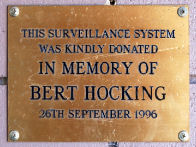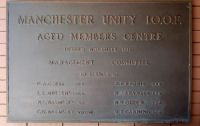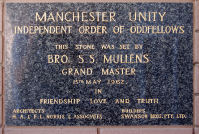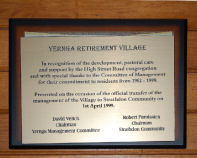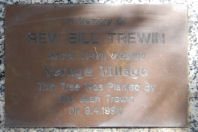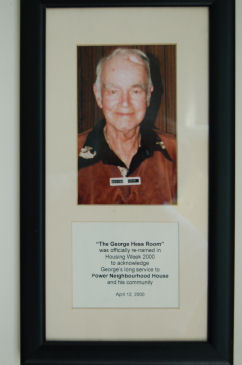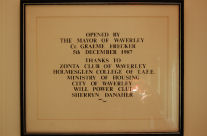60H10
"THE ORIGINAL CHILDREN"
SCULPTURE BY STANLEY HAMMOND, M.B.E.
DONATED TO ASHWOOD HIGH SCHOOL BY M. MCKAY, B.A.
PRINCIPAL 1968-1976
Plaque 2: (East face)
THIS SCULPTURE WAS UNVEILED BY THE HON. A.J. HUNT, M.L.C.
MINISTER OF EDUCATION ON 29 JULY 1980
Access may be gained to the school grounds on weekends but during school hours, an approach would need to be made to the school office with a request to view.
Donated by former principal, Mr. McKay and erected in the school grounds.
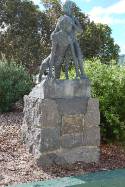
Bicentenary Gift of the Zonta Club of Waverley 1988
61E11
Australia 1788-1988
"THE ZONTA ROSE"
Bicentenary Gift of the Zonta Club of Waverley1988
AUSTRALIA'S BI-CENTENNARY, 1788-1988.
Note,
21/3/2008:
A gift from the Zonta Club for the nation's Bicentenary
in 1988.
Some minor graffiti has appeared on the plaque and shows on the photograph.
Note, 15/4/2008:
Zonta International is a worldwide service organisation
of executives in business and the professions working to
advance the status of women. There are over 33,000
members in more than 1,250 clubs in 67 countries.
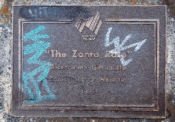
71J11
WAVERLEY IMPRESSIONS
AN ARTS WAVERLEY PROJECT
OFFICIALLY OPENED BY
THE MAYOR
WAVERLEY
CR. BARBARA THOMPSON
ON
29 MAY, 1990
SPONSOR NUBRIK INDUSTRIES
The plaque was placed to commemorate the project undertaken in 1990 to have school children inscribe individual bricks prior to firing in a kiln. The pavers were then laid in a circular pattern.
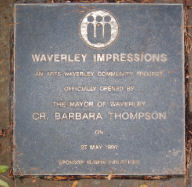
70E1
TIME CAPSULE
TO MARK
VICTORIA'S 150TH
ANNIVERSARY
1984-85
TO BE OPENED
2034-35
Note, 22/10/2008:
When the school closed, the plaque was removed from the grounds and now is with Waverley Historical Society.
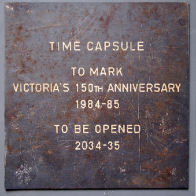
Located just off pathway heading towards the first tee on the east side under tree.
61A11
ERECTED
IN COMMEMORATION
OF OUR LATE
ESTEEMED MEMBER
A E MILLARD
1928
Permission to view should be gained from Riversdale Golf Club.
Erected in 1928 for A.E. Millard who was an early member of Riversdale Golf Club
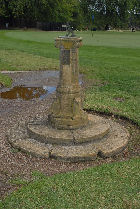
Note:
10/2/2008.
The plaque is located on the footpath where the service
road commences, in front of number 893 Ferntree Gully Rd.
71J9
THE 1905 RALLY, FERNTREE GULLY ROAD WHEELERS HILL
The car came early to Waverley. In July, 1905, theAutomobile Club of Victoria attracted 50 cars (the smallest a tiny de Dion, several Phoenix Trimos and the largest, a Panhard) and a throng of fascinated spectators. One eye-witness wrote: "The climb was over a distance of 1220 yards, (1116 m.) and a rise of 240ft. (73 m.). The panorama of river flat and mountain range was charming in the extreme, and as evening drew on, the purple heather tints which the setting sun reflected on the distant slopes lent an air of enchantment to the outing."
Placed as part of the Victoria 150 celebrations in the City of Waverley by the Council, Spring, 1985.
VICTORIA 150 CELEBRATIONS.
Historical Note,
10/12/2008:
From 1905 to 1940, the steep climb up Ferntree Gully Rd
from the Dandenong Creek to the Wheelers Hill Hotel
formed the hillclimb course for both motor cars and
motorcycles. Another reported course stretched
north along Jells Rd from the Wheelers Hill Hotel and
through surrounding paddocks near Joseph Jell's property
which is today's Jells Park.
At least 50 cars and motorcycles took part in the rally on the testing slope of Wheelers Hill. The steepness of this hill can be seen today although it has been cut down and widened.
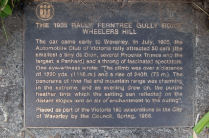
70B2
BAYVIEW PARK
This is the site of the former Bayview Primary School
which opened in 1956 and closed in 1992.
Bayview Park and residential estate were established by
Monash Council in 1996.
Placed to commemorate the opening of the park which is on the site of the Bayview Primary School.
At the end of 1992 Bayview Primary School closed. Both Mt. Waverley P.S. and Bayview P.S. existed in the same 'block' and whilst during the peak days of the late 1960s their combined enrolments exceeded 2000 children, they were now down to little more than 300 for both. With approximately sixty children from Bayview joining the Mount Waverley community for the commencement of the 1993 school year, the enrolment rose to just over 300.
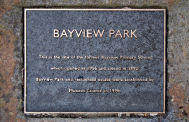
61E1
BAYVIEW SCHOOL LIBRARY
OFFICIALLY OPENED ON
26TH SEPTEMBER,
1969
by
The Principal, CHARLES H. McCORD
Placed originally to commemorate the official opening of the school's library in 1969.
The plaque was removed from its original position when the school and the library were demolished and placed in the care of Waverley Historical Society.
Note, 9/6/2008:
At the end of 1992 Bayview Primary School closed. Both
Mt. Waverley P.S and Bayview P.S. existed in the same
'block' and whilst during the peak days of the late 1960s
their combined enrolments exceeded 2000 children, they
were now down to little more than 300. With sixty
odd children from Bayview joining the Mount Waverley
community for the commencement of the 1993 school year
the enrolment rose to just over 300.
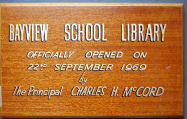
71C5
THE BLACKSMITH'S FORGE, BLACK FLAT, 1885.
In the eighteen-eighties, Melbourne was alive with an economic boom based on the sale of land. Black Flat was suddenly no longer a sleepy siding at the intersection of Waverley and Springvale Roads. David Scammell's forge filled the surrounds with the sounds of metal banging on metal, horses being regularly shoed, drays and carts being restored. J. Duff opened a post office.
Mrs. Ellen Willey opened a general store. Edward Whitely opened a bakery and Summers and Wicke opened a butcher's shop. The Black Flat Hall was built to host balls, dancing classes, concerts and chess championships. The Black Flat Cricket Club was, by 1889, playing one-day matches against teams as far away as St. Kilda. Historian, Susan Priestley comments that this rising township "was becoming the social hub of the district."
Placed as part of the Victoria 150 celebrations by the City of Waverley by the Council, Spring, 1985.
VICTORIA 150 CELEBRATIONS
Historical note, 10/2/2008:
An original shop in the township of Black Flat which grew up around the corner of Springvale and Waverley Roads. David Scammel worked the blacksmith's forge until about 1896.
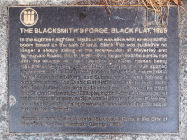
71A4
THE BOONOORUNG TRIBE
C 40,000 B.C. - 1860 A.D.
The Boonoorung tribe roamed through this rolling country "moderately timbered with gum and box" for thousands of years before European settlement. Alexander McMillan of the Scotchman's Creek Run (1840) learned their language, enjoyed their campfire myths, songs and music and remained in awe of their physical skills, strength and stamina. Reverend James Clow of Tirhatuan Run (1843) wrote of this fun-loving, peaceful, friendly and trusting people. Yet, by 1860, these proud people had largely been victims to European enmity, disease and drink: the thirty-five survivors had been moved to a reserve in Mordialloc.
Placed as part of the Victoria 150 celebrations in the City of Waverley, by the Council, Spring, 1985.
VICTORIA 150 CELEBRATIONS
Historical Note:
10/2/2008.
It is a tribute to the nomadic aborigines, who were the
original inhabitants. Acknowledges some of the original
inhabitants of the current City of Monash - the
Boonoorong (Bunurung) peoples.
This plaque may now be considered inaccurate in the light of recent studies which have shown that the Woiwurrong and not the Boonoorong (or Bunurong) were probably the tribal owners of most of what is considered the current City of Monash.
Note: 14/2/2008
Previous pamphlets give the directions as west of
Montague Street, however this street has now been closed
off at Waverley Road.
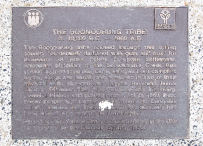
60H10
INSCRIPTION 1:
SHIRE OF
MULGRAVE
THIS BRIDGE WAS
BUILT IN THE YEAR
1926
JOSHUA JORDAN
PRESIDENT
INSCRIPTION 2:
SHIRE OF
MULGRAVE
THIS BRIDGE WAS
BUILT IN THE YEAR
1926
CH COLEMAN JP
ACTING PRESIDENT
When the 1926 bridge was replaced in more recent years, the two original marble foundation stones were placed into the two concrete rail supports on the southern side of the new bridge.
The two plaques were laid by Joshua Jordan and C.H. Coleman for the first permanent bridge over Gardiners Creek in 1926. The area would have been known then as Burwood.
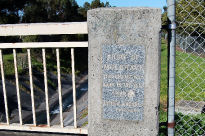
60K7
THIS BRIDGE WAS CONSTRUCTED
BY THE
COUNTRY ROADS BOARD
IN 1965
TO REPLACE THE
ORIGINAL
BRIDGE OPENED BY
THE HON. W.H. EDGAR
22 AUGUST 1913
The plaque is attached to the bridge built in 1965 over Gardiners Creek, Burwood replacing an earlier bridge built in 1913.
This plaque is part of the City of Whitehorse, however because the bridge is part of the boundary between the two municipalities, it has been included.
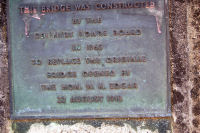
60G12
C.R.B.
1938
Part of the small plaque has been painted over, (very badly!)
Placed to mark the construction of the concrete bridge over Gardiners Creek on the border with City of Stonnington, previously City of Malvern. Construction was by the Country Roads Board and the bridge was opened for traffic in 1938.
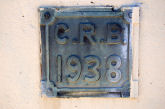
The plaque is located in the centre parkland of the estate.
69J2
BRINDALEE GARDENS
Winner of the UDIA (Victoria) Excellence Award, 1995 in the category of Medium Density Development
Officially opened by the Honourable Robert Maclellan MLA
Minister for Planning, Victoria
2 February, 1996
The plaque is of coated brass and has some superficial damage.
Located to commemorate the opening of the medium density estate on the site of the former Jordanville South Primary School.
Note, 9/6/2008:
Brindalee Gardens, Chadstone
1992 - 1995
UDIA Award
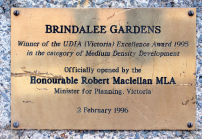
71C5
EAST FACING FACADE:
FOR KING AND COUNTRY
ERECTED AS A
TRIBUTE TO THE MEN OF GLEN WAVERLEY WHO MADE THE SUPREME
SACRIFICE IN THE GREAT WAR
1914-1918
THEIR NAME LIVETH FOR EVERMORE
NORTH FACING
FACADE:
LAW F.
SMITH N
.WHEELWRIGHT H.M.
WEST FACING
FACADE:
LEST WE FORGET
SOUTH FACING
FACADE:
ADAMS, F.
FEAR S.R.W.
HERRIOT W.E.
HORNER C.S.C.
The cenotaph is dedicated to the memory of those men of the Shire of Mulgrave/ City of Waverley who made the supreme sacrifice during World War I and World War II,
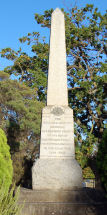
Note: 10/2/2008
- right on the corner of Lum Road, west side.
71F9
THE CHESHIRE CHEESE 1864
In the eighteen sixties a number of rudimentary inns were established throughout the district. One of the earliest was The Cheshire Cheese built here by Robert Wolstenholme with locally cut sandstone. It soon became a staging for Cobb and Company and catered successfully for settlers, timber sawyers, bushmen and travelers. Other early inns were the Notting Hill, The Mulgrave Arms, The Tally Ho and The Mountain View, The Squatters Rest, known also as The No Good Damper, The South Yarra and The Lady Of The Lake. So elegant was this stone that the Anglicans accepted Wolstenholme's offer to donate what he did not need to construct the beautiful St Matthew's Church on Wellington and Springvale Roads corner in 1869. It stood proudly until demolished in 1976.
Placed as part of the Victoria 150 celebrations in the City of Waverley by the Council, Spring, 1985
VICTORIA 150 CELEBRATIONS
Historical note,
10/2/2008:
This hotel was built from local sandstone and later
became known as the Temperance Hotel. Lum Rd was
named after the family who built their wattle and daub
home there.
Existed from 1864, but in 1885 was delicensed and became the home of John brown, from Heidelberg. In 1891 the Cheshire cheese became George Cotter's Temperance Hotel.
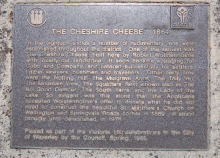
62D2
CITY OF WAVERLEY
HISTORY SERIES
HOLLAND'S GOLD MINE
Circa 1893
Gold was discovered on this site, previously known as Black Flat in 1893, mining continued on into the turn of the century.
This board is one of three of a series which was erected. One other is known but has since been removed:
Cnr. Waverley and Springvale Rds - south side Waverley Rd, east of the Bowling Club.
This commemorated the original site of the Black Flat township.
Also the site of the Holland brothers mine. Little gold was actually found.
Note: 9/3/2008.
Re: condition. The sign is fading and is showing the
signs of weathering.

71C5
CITY OF WAVERLEY
HISTORY SERIES
Springvale Road (circa 1920)
Rural scene along Springvale Road depicting life in the early part of the century, the available shops amid orchards and market gardens typifying early Waverley.
This is one of three such history of Waverley signs placed. However, this has since been removed from its position near Central Reserve and its whereabouts is not known.
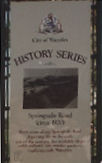
70C3
CITY OF WAVERLEY
HISTORY SERIES
WAVERLEY ROAD
CIRCA 1933)
Commemorating the once-rural aspect of Waverley Road. This photo was typical of all main roads within the Shire of Mulgrave until the coming of the urban population in the 1950s and 1960s. The photograph shows Park Lane on the left and cows, probably belonging to Goffs wandering on Waverley Rd.
There would have been text below the photo, however this has faded and disappeared over time. Original text unknown at this time.
Note, 21/2/2008:
This board is one of three of a series which was
erected. One other is known but has since been
removed. :Cnr. Waverley and Springvale Rds - south side
Waverley Rd, east of the Bowling Club. This commemorated
the original site of the Black Flat township.
Note, 21/2/2008:
Re: condition. The sign is fading and is showing the
signs of weathering.
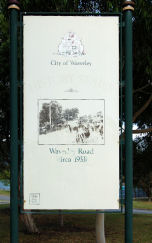
61E1
THIS PEDESTAL AND SURROUNDS
BUILT WITH BRICKS OF THE
CLOSTER HOUSE,
FORMERLY SITED NEARBY - PROVIDES A
TANGIBLE LINK WITH THE HISTORY
OF THE AREA AND IS DEDICATED TO
THE MEMORY OF THE EARLY SETTLERS
OF THE DISTRICT.
The plaque is set in a base constructed from Blackburn pressed bricks from the 1900 home.
The plaque provides no dates or information about who placed it and when. (Probably erected after 1978)
Original bronze sundial has been vandalized or removed from the top of the pedestal.
George and Rosina Closter (formerly Kloster) lived and farmed in Stephensons Road and their house was burnt down, to be replaced in 1900. This was built on Stephensons Rd between Miller Crescent and Holskamp St. After their deaths, Waverley Council purchased the home and it was demolished in 1978.
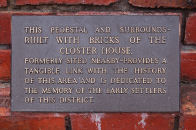
71C3
THE COOK FAMILY
This plaque marks the site of the former Cook family cottage. In 1919, on his return from the war, Philip Everard Cook purchased, with assistance from his brothers Leonard and Bertram 10 acres of land on which the Civic Centre now stands. In 1920 Philip established a poultry farm on the property. He and his brothers and later his mother and sister became actively involved in the community and development of the district.
Placed on "Australia Day" 26 January in the Bicentennial Year of 1988
Cr. G. B. Frecker JP Mayor
Note: 20/2/2008:
This plaque was re-located (several times) from its
original position in front of the main entrance of the
Glen Waverley Library, just a few metres to the west to
avoid damage from skateboarders. The raised lettering may
originally have been gold.
Historical note,
20/2/2008:
Philip Everard Cook purchased land facing Springvale Road
in 1919, with the assistance of his two brothers. Here,
they established a poultry farm on land that was to
eventually house the City of Monash Civic Centre.
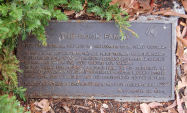
71J10
DAVID DOYLE
Mom and the two kids - demographically Oz, 2001
Fibreglass and marine grade paint finish.
On loan courtesy of the artist.
Mom and the two kids. Demographically Oz by Australian sculptor David Doyle is the new addition to the MGA's sculpture park. Made from fibreglass and measuring around two metres in height, Mom and the two kids. Demographically Oz was a finalist entry in The Helen Lempriere National Sculpture Award in 2001.
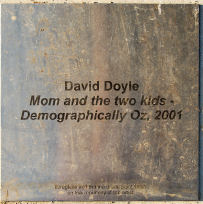
71J10
DAVID WATERS
The Set, 2005
Cast concrete. On loan from the artist
David Waters completed his Bachelor of Fine Arts at RMIT University in 1985. Since this time, David has created public works for various locations across Australia and his sculptural and print work has been included in over 40 exhibitions. He has won several prizes, including the 2005 Montalto Sculpture Prize. David uses a range of materials in unconventional ways, such as wood, canvas, foam, glass and clay to create installation and sculptural works.

71C3
CITY OF WAVERLEY DIRECTORY OF HISTORIC MARKERS
1. THE
BOONOORUNG PEOPLE C.40,000 B.C.
2. THOMAS NAPIER AND MADELINE SCOTT, FIRST EUROPEAN
SETTLERS, 1839
3. THE SCOTCHMANS CREEK RUN, 1840
4. THE TOWN OF "WAVERLEY", 1854
5. THE TOWN COMMON IN HIGH STREET ROAD, 1861
6. THE TOWN COMMON IN WAVERLEY ROAD, 1861
7. THE CHESHIRE CHEESE AND EARLY INNS, 1864
8. ST. STEPHEN'S CHURCH AND COMMON SCHOOL, 1865
9. THE WESLEYAN CHURCH, BLACK FLAT AND SCHOOL, 1867
10. THE TOLL GATES, 1868
11. SIR REDMOND BARRY'S COUNTRY ESTATE
"SYNDAL", 1869
.12. THE TALLY HO INN AND RACE TRACK, 1877.
Sites of Historical Footpath Markers placed as part of the Victoria 150th Anniversary Celebrations 1984 - 1985.
MAP
A COMMUNITY PROJECT SUPPORTED BY MERCEDES BENZ
(AUSTRALIA) PTY. LTD.
13. THE
MULGRAVE STATE SCHOOL, 1879
14. THE GLEN WAVERLEY STATE SCHOOL, 1880
15. THE BLACKSMITH'S FORGE, BLACK FLAT, 1885
16. THE MULGRAVE PRESBYTERIAN CHURCH, 1891
17. GOLD DISCOVERIES, 1893.
18. HORTY HALL, 1899
19. THE AUTOMOBILE CLUB OF VICTORIA, CAR RALLY, 1905
20. TAIT'S POST OFFICE AND STORE, MT. WAVERLEY, 1905
21. MOUNT WAVERLEY STATE SCHOOL, 1906
22. THE GLEN WAVERLEY MECHANICS INSTITUTE, 1908
23. ST. LEONARD'S CHURCH ORIGINAL SITE, 1913
24. THE OLD SHIRE OFFICES, NOTTING HILL, 1921.
VICTORIA 150 CELEBRATIONS
Note, 12/2/2008:
Directory of Historic Markers. Placed in 1984
to mark the placement of 24 markers at various points
within the City of Waverley, it commemorates
Victoria's Sesqui-centenary. The marker was
donated by Mercedes Benz, Australia and was unveiled by
the then Mayor of the City of Waverley, Cr. Russell
Hannan.
The marker was donated by Mercedes Benz, Australia and was unveiled by the then Mayor of the City of Waverley, Cr. Russell Hannan.
Note, 12/2/2008:
Of the original 24 plaques placed for this project, only
one can be considered to be lost.
No. 13 (The Mulgrave State school Plaque) disappeared during roadworks along Wellington Rd at some stage.
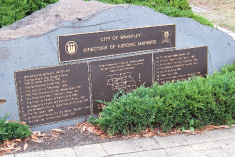
71A8
IN MEMORY
OF
DOUG BELL
WORKS MANAGER
VIC ROADS FOWLER ROAD. DEPOT
Aged 56 Years
28/8/1946 - 7/8/2002
R.I.P.
Note, 21/3/2008.
Access is only possible by stopping on the on-ramp to the freeway. There appears to be no access from the southern side of the embankment.
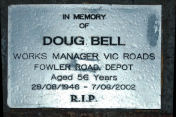
70J3
THIS BRIDGE WAS OFFICIALLY OPENED BY
THE MAYOR OF
WAVERLEY
CR. T. M. HEFFERNAN
ON 29 OCTOBER 1990
A JOINTLY FUNDED PROJECT BY
THE
COMMONWEALTH AND STATE GOVERNMENTS
BICENTENNIAL PROGRAM,
VICROADS AND WAVERLEY CITY COUNCIL.
DESIGN AND PROJECT MANAGEMENT
WAVERLEY CITY COUNCIL.
A footbridge to span busy Blackburn Road was built in the Scotchmans Creek gully in 1990. It connects the consulting/medical suites to the east of Blackburn Road with Waverley Hospital and provided a continuous bike path through Scotchmans Creek Linear Park.
This 11 km path bisects the municipality into Northern and Southern sections. It begins at Warrigal Road and intersects with the Dandenong Creek Path at the picturesque Jells Park. Areas of interest include sports grounds, Monash Aquatic and Recreation Centre, Oakleigh Recreation Centre, Glen Waverley Police Academy, Brickmakers Park, Waverley and Oakleigh Golf Courses and Monash University.
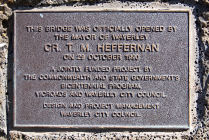
71F3
25th ANNIVERSARY
MOUNT VIEW PRIMARY SCHOOL
THIS
PLAQUE COMMEMORATES
THE HISTORICAL ASSOCIATION OF THIS TREE WITH THE HOME OF
THE PIONEER GALLAGHER FAMILY AND 25 YEARS OF EDUCATION AT
MOUNT VIEW. 11/10/1990.
UNVEILED BY
MR. J. F. MURPHY
ON THE 21.10.1990.
Peter Gallagher selected land along Minogue's Road (now Gallaghers Road) in 1871 - 128 acres running east to Dandenong Creek. He and his wife Rose, built their home facing the present Shepherd Road where they raised their family. Descendents were still farming the property when the Education Department bought the top section of the land for a school in around 1965.

61A11
PLANTED IN MEMORY OF GEORGE W. NAISMITH 1928- 1963. DIED 25-5-83
Permission should be gained from Riversdale Golf Club to view.
Note,
9/6/2008:
Shortly after the move to St. Johns Wood, George Naismith
was appointed Professional to Riversdale, a position he
held for some 34 years. A fine golfer, Naismith was
Victorian Professional Champion in 1932 and 1934 and won
the Australian Open in 1937. Apart from his outstanding
golfing record, George Naismith is well known as the
early mentor of two later golfing greats Peter Thomson
and David Graham, both of whom were Assistant
Professionals at Riversdale.
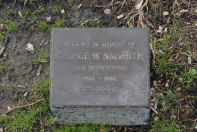
71D1
THIS PLAQUE WAS UNVEILED BY MR. I. M. HALL REGIONAL DIRECTOR OF EDUCATION TO MARK THE PLANTING OF 25 TREES IN CELEBRATION OF OUR SILVER ANNIVERSARY
Note, 21/3/2008:
Access is restricted. Access at weekends is open, however
during school hours, inquiries should be directed to the
school office.
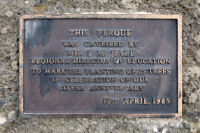
71C5
THE GLEN WAVERLEY MECHANICS INSTITUTE
On this site stood the Glen Waverley Mechanics Institute. Built by community effort, it opened on August 18th, 1909 and was used as a meeting hall, committee rooms and library until destroyed by fire on September 10th, 1956.
Placed as part of the Victoria 150 celebrations in the City of Waverley by the students of Caulfield Grammar School, Autumn, 1985.
VICTORIA 150 CELEBRATIONS
Note, 10/2/2008:
On October 2,1907,12 men bought ten acres of land in
Springvale Road, to provide an athletics ground. A
Mechanics' Institute Hall was built on half an acre of
this land and opened on 18 August 1909.
After much community enthusiasm and physical effort, a recreation reserve was opened in 1908 and a Mechanics Institute Hall in 1909. Two front rooms were added in 1926 but the whole building was destroyed by fire in 1956 when it was being used as a temporary school room.
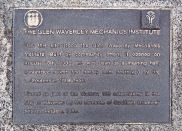
71C4
THE GLEN WAVERLEY STATE PRIMARY SCHOOL, No 2219
Erected on this site, 1880, being the first permanent school building in the City of Waverley.
Placed as part of the Victoria 150 celebrations in the City of Waverley by the students of the Glen Waverley Primary School, Autumn, 1985.
VICTORIA 150 CELEBRATIONS
Historical note,
10/2/2008:
The first school was held in the Wesleyan Chapel which
later became a state school. The new brick school with
residence was built on this corner in 1880 and this
building can still be seen. On the opposite corner was
the site of an early General Store and Post Office.
The building is currently leased to Le Pine and Sons for use by them and also as a community meeting place. This current lease expires in 2009.
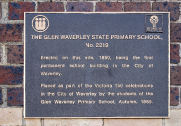
There are plaques on the panels and a polished black granite plinth on the western (Kingsway) side of the memorial.
71C3
WEST FACING PLINTH:
PASS NOT IN THIS PLACE IN SORROW BUT IN PRIDE AS MAY YOU LIVE NOBLY AS THEY DIED KNOWING THAT THEIR DEATH IN FREEDOM'S CAUSE STANDS AS A BEACON LIGHT TO POINT THE WAY TO PATHS OF PEACE.
"LEST WE
FORGET" THIS MEMORIAL COMMEMORATES THE MEN AND WOMEN
OF THE FORMER CITY OF WAVERLEY AND SHIRE OF MULGRAVE WHO
SERVED THEIR COUNTRY, AND THOSE WHO PAID THE SUPREME
SACRIFICE.
JANUARY 1999
WORLD
WAR I
1914-1918
ADAMS F.
ALCOCK J.
BARKER F.
BATTEN T.
BENNETT F.T.
BRAY R.L.
BRENNAN W.J.
BROWN S.
CAMPBELL W.
CORNELL E.
CROW W.
DOOLAN W.R.
DOVER T.E.
FEAR S.R.W.
FURPHY A.F.
HERRIOTT W.E.
HORE S.E.
HORNER C.S.C.
KELSELL W.J.
LAW F.
MUNRO A.M.
MCPHERSON A.R.
MCPHERSON L.J.
SMITH N.
WHEELWRIGHT H.M
WHITE D.C.
WORLD
WAR II
1939-1945
COOPER A.D.W.
COVENTRY H.F.
EZZARD R.H.
FEW W.J.
FOSTER B.
FREESTONE T.G.
GREENWOOD L.J.
KERFERD L.G.
MARWICK H.G.
MATTHEWS R.G.
MOORE A.T.
PARKINSON J.
SOMERVILLE J.
VOUSDEN G.V.
WILSON E.R
VIETNAM
1962-1973
DAVIES R.E.
HARTNEY G.J.
WATSON R.C.A
This recently constructed Memorial carries a number of polished bronze plaques and is dedicated to those locals who served and died in all wars and conflicts. Erected in 1999.
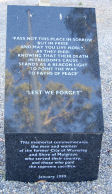
62D12
GOLD DISCOVERIES, 1893 - 1905
In these gullies running eastward to Dandenong Creek, several shafts were sunk between 1893 and 1906. Quartz taken from the "Hollands Reward" mine yielded six ounces of gold to the ton. "Sydney Jim" Bridges, boasting "heyes like a heagle" spotted gold midst the mullock heaps adjoining the Mountain View Hotel. The "Black Flat North Gold Mining Company" and the "Mountain View Gold Mining Company were formed. A rush had begun in which sightseers were to outnumber miners.
Placed as part of the Victoria 150 celebrations in the City of Waverley, by the students of Highvale High School, Autumn, 1985.
VICTORIA 150 CELEBRATIONS
Historical note, 10/2/2008:
Gold was first discovered near the Mountain View Hotel by a digger named James Bridge. Phillip Holland and his sons obtained gold from the reef near the hotel. The Mountain View Hotel, now modernised, has functioned since 1877.
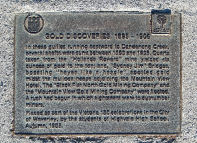
61A11
A TRIBUTE
TO THE MEMORY OF
HARRY HIGHAM
A VALUED AND FAITHFUL
EMPLOYEE OF THIS CLUB
FOR 35 YEARS
1927-1962
Permission to view should be gained from Riversdale Golf Club.
Biographical
note, 4/6/2008.
Harry Higham, 1890-1962.
Harry Higham was born on May 27th, 1890 in Lancashire England. he lived first at Blackpool. At the age of 10, he left school to earn his living and help support his widowed mother.
In the following years he worked in the market gardens around Blackpool, before coming out to Australia in 1911, at the age of 21.
In Australia he worked on the land, mainly in market gardens around Melbourne. During World War I he served in the Merchant navy and on hospital ships between India and the Middle East.
On the 29 March 1919, he married Jessie Brewer, daughter of James Brewer, the owner of St. John's Wood, now Riversdale Golf Links.
When St. John's Wood was sold to Riversdale, he stayed on, helping lay out the course and then as greenkeeper, took charge of the course and grounds until ill-health forced him to retire many years later.
During those years as greenkeeper he also planted most of the trees at Riversdale and also laid out and cared for the gardens in front of the club-house, always a delight to see.
When the bowling green was laid out, he took over its care and maintenance, leaving most of the other course duties to his assistants.
On many an occasion in hot weather, he would make a special trip over the weekend to hand water his bowling green. Ill health forced his retirement and he died on September 24, 1962.
A small memorial plaque is under a silver birch tree beside his beloved bowling green.
M.J.W.
Written by his daughter,
Mary (Higham) Wolf in Adelaide, S.A.
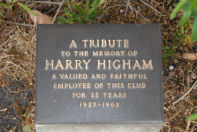
62F2
DONATED BY HIGHVALE DISTRICT GUIDE AND BROWNIE ASSOCIATION COMMEMORATING THE BICENTENNIAL 25 JUNE 1988.
AUSTRALIA'S BI-CENTENNARY, 1788-1988.
Note, 17/3/2008:
The plaque is showing signs of scratching on the surface.
Located to mark the installation of a street seat marking the occasion of the country's Bicentennial, 1988.
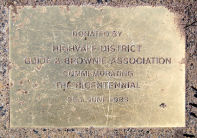
Note: 13/2/2008. Located in front of 486 High Street Road.
61H12
"HORTY HALL", MOUNT WAVERLEY, 1899.
On the crest of this hill, over-looking the now renowned orchards of High Street Road, Secretary J. B. Brewster designed and built the Mt. Waverley and District Horticultural Hall. So began a new focus for community life: concerts, glee clubs, dances, theatricals, educational lectures, meetings, schools, speech nights, and even wrestling displays graced this beautiful timber building with its rusticated block fronted and iron cresting, its moulded panel ceiling, its Kauri seats and its handsome nickel lamps for a cost, including land of less than £200, ($400).
Placed as part of the Victoria 150 celebrations in the City of Waverley by the Council, Spring, 1985.
VICTORIA 150 CELEBRATIONS
Historical note
13/2/2008:
The Mt. Waverley and District Association had been part
of the Boorondara, Nunawading and Mulgrave Horticultural
and Fruitgrowers Association.
Built for the staging of horticultural shows,'Horty Hall' became a focus for community life - concerts, dances, meetings, etc. Known locally as "Horty Hall". Now demolished.
Joshua Brand Brewer had lived at "St. John's Wood", previously connected with Sir Redmond Barry and his mistress, Louisa Barry.
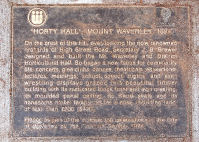
71K6
THIS TREE WAS PLANTED BY
NORMAN J. SPARNON O.A.M.
TO CELEBRATE 25 YEARS OF IKEBANA INTERNATIONAL IN AUSTRALASIA
29TH MARCH 1984
Note,
21/3/2008:
IKEBANA is the Japanese art of flower arrangement.
IKEBANA is more than simply putting flowers in a
container. It is a disciplined art form in which the
arrangement is a living thing in which nature and
humanity are brought together. It is steeped in the
philosophy of developing closeness with nature.
As is true of all other arts, IKEBANA is creative expression within certain rules of construction. Its materials are living branches, leaves, grasses, and blossoms. Its heart is the beauty resulting from colour combinations, natural shapes, graceful lines, and the meaning latent in the total form of the arrangement. IKEBANA is, therefore, much more than mere floral decoration.
The growing appreciation of Japanese art and architecture in the West has extended to the Japanese way with flowers. IKEBANA is an art, in the same sense that painting and sculpture are arts. It has a recorded history; it is backed up by articulate theories; and it is concerned with creativity. In Japan, flower arrangements are used as decorations on a level with paintings and other art objects.
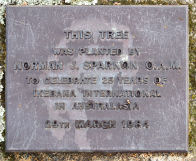
71J10
INGE KING
Born Germany, 1918, arrived Australia, 1951.
NAYADS
1997, Warrandyte, Melbourne.
Purchased through the Art Foundation of Victoria with the assistance of J. B. Were and Sons, Governors, 1997.
Inge King was born in Berlin in 1918. She commenced formal studies at The Academy of Fine Arts in Berlin and later was awarded a scholarship to study at The Royal Academy in London. After studying there for one year she enrolled at the Glasgow School of Art, where she graduated and joined the teaching staff. She also studied in Paris and in New York. Before arriving in Australia in 1950, she held an exhibition at the London Gallery, Brooke Street.
In Australia, Inge King became a foundation member of the Centre Five group. Other members include, Julius Kane, Clifford Last, Lenton Parr, Vincas Jomantus, Teisutis Zikaras.
Inge King is represented in public and private collections in Australia and overseas and is best known for her many public commissions.
1998
Note, 16/3/2008:
Inge King - b. 1929, lives in Warrandyte, Victoria.
In her early sculpture King worked with a variety of
materials, although the modern media of arc welding and
industrial steel characterize most of her work after
1960. King's geometric abstractions challenge the viewer
to explore the formal relations of space in and around
her work and to consider the figurative allusions made in
her titles. When Inge King executes monumental projects,
such as Surge Forward, she works with a team of engineers
and welders to enlarge and install her Marquettes.
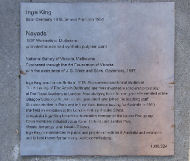
JOHN KELLY
Marquette for a public monument
2003
rusted corten steel 3/3
on loan courtesy of the artists and Niagara Galleries
The English born sculptor John Kelly grew up in Australia but is now living in Ireland. It’s not the first unusual or exotic location for a John Kelly sculpture. His previous exhibits include Cow up a tree (which featured in The Times) at the Les Champs de la Sculpture (1999) on the Champs Elysees, Paris. The public debut of Three cows in a pile was at La Parade des Animaux, in the Casino Gardens in Monte Carlo in 2002. Both Cow up a tree and Three cows in a pile were cast at the famous Courbetin Foundry, Paris.
In 1994 John Kelly was awarded a residency at the Australia Council studio in Barcelona which was followed in 1995 by an exhibition of his work Piccadilly Gallery in London. In late 1996 he received a twelve months Samstag Scholarship to study at the Slade, London. The Samstag Scholarship was crucial in allowing him to live and work in London.
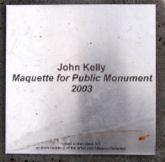
71C3
City of Monash
The City of Monash is proud to acknowledge the Clans of the Kulin Nation who previously occupied the land
This commemorative plaque was unveiled during NAIDOC (National Aborigines and Islander Day Observance Committee) Week
On 8 July 2002
by the Mayor
Cr Geoff Lake
Councillors
Peter Holdsworth Paul Klisaris Matthew Evans Kathy
Magee Tom Morrissey Felicity Smith Peter Vlahos
Historical Note, 9/6/2008:
About The Wurundjeri People:
The Kulin nation comprised a number of clans and the Woi
wurrung and more specifically, the Wurrundjeri hunted and
lived in the area we now know as the City of Monash.
The first people that occupied the Melbourne area prior to European colonisation were the Woiwurrung language group, specifically the Wurundjeri people.
The following is a list of the clans within the Wurundjeri area:
Wurundjeri-balluk & Wurundjeri-willam (Yarra Valley Yarra River catchment area to Heidelberg)
Balluk-willam (south of the Yarra Valley extending down to Dandenong, Cranbourne, Koo-wee-rup Swamp)
Gunnung-willam-balluk (east of the Great Dividing Ranges and north to Lancefield) Kurung-jang-balluk (Werribee River to Sunbury) Marin-balluk (Boi-berrit) (land west of the Maribyrnong River and Sunbury) Kurnaje-berreing (the land between the Maribyrnong and Yarra Rivers)
Boundaries
The territory of the Wurundjeri lies within the inner
city of Melbourne and extends north of the Great Dividing
Ranges, east to Mt Baw Baw, south to Mordialloc Creek and
west to Werribee River.
Language /
terminology
Some key terms of Woiwurrung language (and their English
equivalent) are noted here:
Bulluk / balluk - swamp
Nira - cave
Willam / wilam / Illam / yilam - hut, camp, bark Gunung / Gunnung - River
Totems :
The two moeity totems of the Wurundjeri people are Bunjil
the Eaglehawk and Waang the Crow.
Places of
Significance
The Wurundjeri are the traditional owners of a large part
of the land of inner and outer Melbourne.
The Yarra River was central to the Wurundjeri people as it provided a variety of foods such as eels and fish. Along its fertile banks the numerous variety of native animals and plants would be found.
There are a number of identified significant sites, in particular those found near the Yarra & Maribyrnong Rivers and the Merri Creek. A place of great gathering occurred at the Bolin Bolin Billabong in Bulleen where sacred and social interaction between the clans would take place. The Wurundjeri would also gather with other members of the Kulin Nation on the land where the Melbourne Cricket Ground (MGC) now stands. Other places of significance for the Wurundjeri people are:
Coranderrk Mission Station (Healesville)
Pound Bend (Templestowe / Doncaster)
Mt William Aboriginal Stone Axe Quarry Dights Falls area (Collingwood)
Heide Scarred Tree (Templestowe)
The Sunbury Rings (Sunbury)
Featuring prominently in Wurundjeri story is William Barak, the last traditional great Ngurungaeta or leader of the clan, who witnessed the signing of the 'treaty' between Woiwurrung and Boonerwrung Elders and John Batman. The Ngurungaeta of the Wurundjeri clan at that time was his father Bebejern, from whom Barak inherited the title.

71J10
LISA YOUNG
Curlique 2002
steel, paint
on loan from the artist
Lisa Young's focus is the core elements of transportation, the mechanical units that work in unison to propel and create movement. She has interpreted a variety of cogs, gears, pulleys, levers, wheels, axles, and circuitry to create inventive prototypes for phantasical, meandering mechanics. Illustrating driving forces behind motion; velocity, cause/effect and momentum.
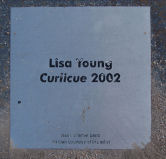
71C5
CITY OF WAVERLEY
PINUS HALEPENSIS - ALLEPO PINE
THIS TREE IS A
DIRECT DESCENDENT
OF THE "LONE PINE" AT GALLIPOLI.
GROWN BY THE FORESTS COMMISSION OF
VICTORIA FROM SEED COLLECTED IN 1976.
PRESENTED BY WAVERLEY R.S.L.
AND PLANTED BY HIS WORSHIP THE MAYOR
CR V.P. LeGRAND J.P.
ON REMEMBERANCE DAY, 1981
Historical
note, 9/6/2008:
THE BATTLE OF LONE PINE:
Lone Pine was one of the three attacks planned in order to create a diversion for a British landing in Suvla Bay, and was carried out by the 1st Division, which consisted of the 1st, 2nd, and 3rd Brigades. At 5:30 pm on August 6th, 1915 these men attacked when the sun was at their backs, and in the Turkish eyes.
The first wave of men were astonished to discover that their objective, being the Turkish frontline, was completely covered in logs and earth. This gave the Turkish soldiers the opportunity to fire safely from a point blank range, and made entry for the Australians nearly impossible. C.E.W Bean, who was observing this scene from the Australian trenches, described the soldiers as "a crowd not unlike that lining the rope around a cricket field". However it wasn't long before the men began to enter the communication trenches which were connected to the front trench allowing them to join their comrades who had dragged off the heavy log cover at the front.
Wave after wave of Australians continued to enter the dark and deadly trenches that were crammed full of dying and fighting men. Because the fighting was so close, there was no room to use a bayonet or throw bombs. Instead, hands and the swords from the bayonets were the substitute weapons.
By six pm the same day the trenches were taken, but the ANZACs defended and endured the Turkish counter attacks on their former trenches for five days, eventually gaining complete control of the Lone Pine objective.
During the attack, many men ran over the top of the Lone Pine trenches to discover massive amounts of Turkish reinforcements waiting in the depression behind the font line. However they never lived to tell the tale as they were killed instantly. In 1920 these bodies were found and were commemorated on the Lone Pine Memorial dedicated to the missing.
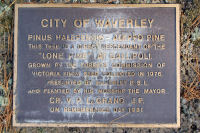
71D1
McDONALDS.
THIS TIME CAPSULE WAS SEALED IN PLACE ON TUESDAY, OCTOBER 2, 1973, TO MARK THE GRAND OPENING OF THIS RESTAURANT, WHICH WAS THE FIRST TO BE ESTABLISHED IN VICTORIA.
THE TIME CAPSULE WILL BE OPENED ON OCTOBER 2, 2000.
IT CONTAINS THE FOLLOWING ITEMS:-
DAILY AND LOCAL NEWSPAPERS FOR TUESDAY, OCTOBER 2, 1973.
CURRENCY: COINS TO THE VALUE OF A BIG MAC.
1973 FEDERAL BUDGET.
VARIOUS MCDONALDS EQUIPMENT AND THE ITEMS OF INTEREST FROM THE YEAR 1973.
Placed in 1973 to commemorate the opening of the first McDonalds Fast Food outlet in Victoria. The plaque was originally located in the garden bed on the west side of the building in 1973. Because it is now in a different location and inside the building, it may be assumed that when the time capsule was lifted in 2000 as stated on the plaque, it may have then been re-placed in its current position at that point.
Alternatively, it may have been located in its present position when remodelling and refitting was done on the restaurant c.2007.
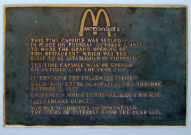
71C5
NORTH PILLAR:
R.A.N. Stoker
II COOPER, A.D.W.
R.A.N. Stoker WILSON, B.R.
VX 59470 Cpl. EZZARD, R.H.
VX 35404 Private FEW, W.I.
NX 37837 L/BDR. GREENWOOD, L.J.
VX 8335 Private KERFORD, L.G.
VX24372 Private MARWICK, H.G.
V29032 Private MATTHEWS, R.G
SOUTH PILLAR:
THESE MEMORIAL
GATES
WERE ERECTED IN MEMORY OF THOSE WHO MADE THE SUPREME
SACRIFICE IN THE GREAT WAR 1914 - 1918.
The two bronze plaques are mounted on the two supporting Lilydale sandstone pillars, both facing east. They were erected in 1949 to serve as the original entrance to the War Memorial. Dedicated to those who died in World War I. They replaced gates which deteriorated and required replacement.
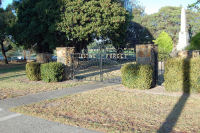
61D11
WINDOW 1:
TO THE GLORY OF GOD AND IN LOVING MEMORY OF MALVINA COLEMAN SHE LIVED TO SERVE
GIVEN BY HER HUSBAND AND SON. DEDICATED BY FREDERICK WALDERGRAVE HEAD ARCHBISHOP OF MELBOURNE. OCTOBER 1ST 1959.
WINDOW 2:
TO.THE.GLORY.OF.
GOD AND.IN.THE.
MEMORY. OF.THE.PIONEERS
.OF.THIS.CHURCH
DEDICATED.BY.THE.
RIGHT.REV.J.J. BOOTH
AUGUST 11TH.1940
WINDOW 3:
THOSE.WHO.GAVE THEIR.LIVES
J.ALCOCK.
B.ATKINSON.
F.T.BENNETT.
E.CORNELL.
W.R.DOOLAN.
S.E.HORE.
THOSE.WHO. SERVED.
K.C.BENNINGTON.
C.CORNELL.
L.R.DUNIZE.
H.R.HORE.
W.MUNYARD.
R.B.SMITH.
J.J.TURNER.
BRYCE-PEARCE.
TO.THE.GLORY.OF.GOD.&.IN.HONOUR.OF.THE.MEN.OF.ST.STEPHENS CHURCH.MOUNT.WAVERLEY.WHO.SERVED.AND. SOME.WHOM.MADE.THE.SUPREME.SACRIFICE.DURING .THE.GREAT.WAR.1914-1919
PRO.DEO.PRO.ECCLESIA.PRO.PATRIA.
Permmision to view should be gained from St Stephens Church.
Old St. Stephens was the first church built in Waverley and is now the oldest standing church building in Waverley. It is built from hand-made bricks and contains three memorial windows dedicated to pioneers of the district and those who served in World War I.
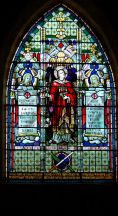
70E1
MIMOSA PAST PRINCIPALS
1973-6 F.T.
Holmes
1977-8 D.R. Williams
1979 N.M. Ainsworth
1980-3 R.A Crawford
1988- B.G. Gosling (Acting)
1989-94 J.G. Ragas
MIMOSA PRIMARY SCHOOL VOLUNTARILY CLOSED ON 22-12-94
Listing all principals of the school from 1973 to 1994. This plaque, along with other memorabilia was donated to Waverley Historical Society by Mr. Norm Barry, former caretaker of the school.
Originally hung near the school office.
He added a small
engraved metal plaque:
Donated by the Barry Family

70E1
MIMOSA PRIMARY SCHOOL
THIS SCHOOL WAS OFFICIALLY OPENED ON THE 27TH DAY OF OCTOBER, 1973 BY MR. G.P. HAYES, M.P.
The plaque was removed on the closure of the school and kept safely until handed to Waverley Historical Society for safekeeping.
Originally placed at the school to commemorate the official opening of the school in 1973.

On the north side off the third tee just near pathway.
61A11
IN MEMORY OF
MORRIE SILK
CAPTAIN 1988 - 1990
PRESIDENT 1998 - 1999
THE RIVERSDALE GOLF CLUB
FOUNDATION
2001
Permission to view should be gained from Riversdale Golf Club. Placed in 2001.
Note, 9/6/2008:
Morrie Silk was club captain and president of Riversdale
Golf Club between the years 1988 and 1999. He died in
December 1999.
Morrie Silk was the father of police officer Sergeant Gary Silk who, with Senior Constable Rod Miller was shot during a robbery stake-out at Moorabbin on August 16, 1998.
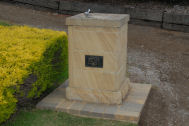
70E2
Melbourne's First Premium Station
The honourable
Alan Brown
Minister for Public Transport
Officially launched Mount Waverley Station as the Met's first Premium Station
Wednesday, 18
January, 1995
The Met
Erected to commemorate the opening of the new rooms at Mt. Waverley station as Melbourne's first Met Premium Station.
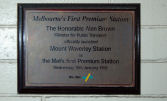
Note: 13/2/2008: located directly opposite the intersection of Park Lane with Kemp Avenue.
70D3
THE MT. WAVERLEY STATE SCHOOL
"On 24 April, 1906, Mt. Waverley State School opened on its present site with thirty-five pupils, reaching a maximum enrolment of 1141 in 1968. The original building comprised a timber schoolroom and porch, the first Head Teacher being Mr. Jonas Key."
Placed as part of the Victoria 150 celebrations in the City of Waverley by the students of Mt. Waverley Primary School, Autumn, 1985.
VICTORIA 150 CELEBRATIONS
Historical note,
13/2/2008:
By 1901, there was mounting pressure by locals in the
central part of the shire to have a school, but a
suggested site to be donated by John Peggie was rejected.
In 1904 another deputation successfully persuaded the education minister to act and two acres of Closter's back paddocks was obtained. Five years later overcrowding caused lessons to be taken in the shelter shed.
In 1905, on a two acre site donated by residents, the Education Department built a school. A new room was added in 1912.
By the time extensions were being done in early 1914, some classes were being taught at nearby 'Horty' Hall. From 1953 the population increased until there were 1141 children on the roll in 1968.
Note: 15/10/2008. The
laneway which once led from Waverley Road, north to the
school can still be seen.
Note 2/12/2008:
New buildings on the site were completed during the last
term of 2008.
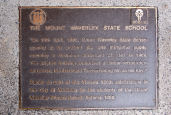
Note: 10/2/2008.
On the footpath directly in front of the old hall.
PRESBYTERIAN CHURCH
The Mulgrave Presbyterian Church was opened on the 19th July 1891 by Reverend A. Yule. On this day, two services were held with one hundred and fifty people attending each. The cost of the building amounted to £173.18.2
Placed as part of the Victorian 150 celebrations in the City of Waverley by the students of the Wheelers Hill High School, Autumn, 1985.
VICTORIA 150 CELEBRATIONS
Historical note,
10/2/2008:
Opened is 1891 in a small weatherboard hall which still
forms part of the church complex. The old church has been
moved back twice because of a road widening and now forms
a part of a modern complex.
With the decision to widen Ferntree Gully Rd and create a northern service road, the old weatherboard building was moved back from the roadway to its present spot. (Date moved - unknown, possibly c. 1975-80?)
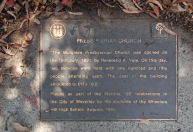
Note 13/2/2008: Located adjacent to the eastern boundary of Monash Administrative Offices, 20 metres west of Blackburn Rd.
70G8
THE OLD SHIRE OFFICES, (NOTTING HILL)
"This plaque commemorates the site of the Notting Hill Shire offices which were on this corner of Ferntree Gully Road and May Road (now Blackburn Road). The land was purchased for £400 and the offices opened in 1921."
Placed as part of Victoria 150 celebrations in the City of Waverley, by the students of Monash High School, Autumn, 1985.
VICTORIA 150 CELEBRATIONS
Historical note,
13/2/2008:
The establishment of the Shire offices at Notting Hill on
Ferntree Gully Rd had a long history. Moves to move the
Council centre from Oakleigh had been made between 1908
and 1914, but none succeeded. Even the proposal to move
the Oakleigh buildings and the drawing up of plans for a
new building on the site, all failed.
By 1920, it was revealed that the cost for a Shire building on the Notting Hill site would cost 12 hundred pounds. Because of shortages in bricks and timber, progress on the new building was slow, but the foundation stone was laid in August, 1920. Power was connected to the building in June 1926.
By 1959, the building was gone, to be replaced by a petrol station.

Note: 21/2/2008. Opposite the main entrance to Avila College, Charles Street.
61F12
CITY OF MONASH
This site is part of the original Waverley Township subdivision created by Dr. J. Silverman in 1854 (refer to plan). Portions of the original township pattern were lost when the railway line passed through the area in 1930.
The land comprised two gullies and stringy bark ranges. A remnant gully with indigenous vegetation can be found at the High Street Road/Stephensons Road intersection.
In naming the area, Dr. Silverman drew upon the novel "Waverley" by Sir Walter Scott. The large estate described in the novel comprised pleasant forested areas and lush gullies. In the novel, Waverley was associated with, "peace and stability, for social and political cohesion and harmony."
The street names chosen by Dr. Silverman reflected the Jacobite period of the story. Waverley was the municipalities name from 1961-1994 and the name is retained in the suburbs of Mt. Waverley and Glen Waverley.
See also marker 4, south east corner of High Street and Stephensons Roads.
This site was originally intended to be the site of a township bearing the name "Waverley". Dr. Silverman who bought the land in 1854 had grand plans. However, the scheme did not eventuate.
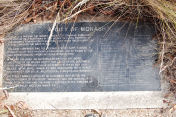
61A11
IN LOVING MEMORY OF
PILOT OFFICER BRUCE ELWELL HISLOP
KILLED IN AIR
COMBAT ENGLAND
18 SEPT 1941
ERECTED BY HIS
PARENTS & SISTERS
PER AROUA AD ASTRA
Permission to view should be gained from Riversdale Golf Club.
Bruce Hislop, a member of Riversdale Golf Club was killed on active duty during World War II.
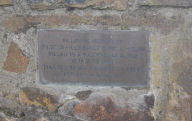
61A11
Erected by his wife and parents
in loving memory of
Pilot Officer Leonard G Sellars
Killed on active service in England
22 July 1942
Permission to view should be gained from Riversdale Golf Club.
Pilot Officer Leonard G Sellars, member of Riversdale Golf Club was killed on active duty during World War II.
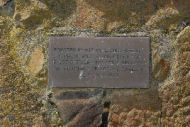
60J6
ORIGINAL PLAQUE
F.C. ROSS
2700 E 12TH BATT
CRB PLAQUE
COUNTRY ROADS BOARD
THIS TREE WAS PLANTED TO COMMEMORATE F.C.ROSS
KILLED IN ACTION IN FRANCE IN 1917 THE ORIGINAL PLAQUE WAS UNEARTHED HERE DURING ROAD CONSTRUCTION IN 1974.
A memorial to Pte. Frank Colin Ross, killed in action on 25 February 1917. The original plaque was uncovered in 1974 during road works for the Monash Freeway. In 2006 VicRoads made repairs to the original concrete setting made by Country Roads Board and set the two plaques ona wider concrete base.
The Australian War Memorial "First World War Nominal Roll", lists a private Frank Colin Ross (5761) of the 12th Battalion who was Killed in Action on 25 February 1917. However, his service number is listed by the AWM as 5761 and not 2700. There may be an error here in either the AWM Roll or the original bronze plaque.

70B7
THE PROWD FAMILY
This plaque marks the place where William Prowd decided to settle.
William (1817 - 1901). A gentleman farmer from Armagh, Northern Ireland and his wife Mary (nee Doolan 1818 - 1897) arrived in Victoria in 1851. William purchased land in the Parish of Mulgrave north of Ferntree Gully Road from the crown in 1853. His family consisted of five sons and a daughter, the sons assisting on the farm.
William, a devout Anglican, helped to initiate a Sunday School at the Oakleigh Church of England and petitioned for the establishment of the Oakleigh State School.
Charles, (fourth son) and his wife Elizabeth (nee Christie) opened up a gravel pit and continued to farm their portion of the property. After the sale of several acres, they donated land for a private road known as Stanley Avenue to provide access to new residents. For over a century 65 acres remained in the ownership of the Prowd family.
Placed by the
City of Waverley on 25 November 1990.
Cr. T. M. Heffernan JP
Mayor
The Prowd family (AKA. Prout) from Ireland were amongst
the first landowners in the Mulgrave-Oakleigh district.
William and Mary bought land north of Ferntree Gully Road
in 1853 and set about farming with his children.
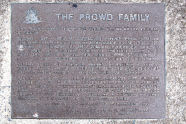
61A11
RIVERSDALE
GOLF CLUB
PLANTED IN
THE CENTENARY YEAR 1992
COPPER BEECH
FAGUS SYLVATICA PURPUREA
Note, 9/6/2008:
Riversdale Golf Club had its beginning during the early
part of October 1892 & can proudly claim to be the
second oldest Golf Club in Victoria - only Royal
Melbourne has a marginally longer history.
Originally formed as Surrey Hills Golf Club the Club was located at Mont Albert some 6 kilometres north of its present location. In 1907 the club moved to Camberwell and a short time later changed its name to Riversdale Golf Club, retaining this name when it moved to the present location at St. Johns Wood, Mount Waverley in May 1927.
From its early days as a country estate owned by Sir Redmond Barry (famous as the Judge who sentenced Ned Kelly to death) the property has been developed into what is undoubtedly one of the most picturesque golf courses in Victoria with numerous varieties included in the thousands of trees which line the Clubs fairways and providing a testing challenge for even the straightest of hitters.
Riversdale's first Clubhouse building consisted of Sir Redmond Barry's original home together with additions carried out during 1927/1928. The larger ground floor rooms of the homestead were left basically intact but the roof was raised to enable addition of upstairs rooms and the existing basement was excavated further to provide locker room accommodation. The renovated Clubhouse was featured in the Australian Home Beautiful magazine during a 1929 series on golf clubs of Victoria and copies of the article are on display in the existing Clubhouse. The building remained in this form until further alterations were completed in 1955 with the addition of the current Bar.
Further additions were completed in 1988 with provision of improved administration facilities, a new entrance to the building and major alterations made to the Clubs liquor storage area. Toilets were installed adjacent to the Lounge and Dining Room together with extensive upgrading of the Kitchen facilities which service the excellent dining facilities available.
Although altered three times over the years, the Clubhouse remains on its original site and still contains considerable portions of the original homestead purchased with the property in 1927 and thus serves as a tangible part of the continuing history of Riversdale Golf Club.
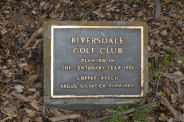
72A6
ROSTRUM VICTORIA GOLDEN JUBILEE
This Angophora commemorates Victorian Rostrum's Golden Jubilee
"I promise not to be silent when I ought to speak."
Placed to celebrate the Golden Jubilee of the organisation.
Rostrum is an Australian organisation made up of small clubs situated throughout the country. Members help each other to increase their confidence and improve their speaking skills in a warm, friendly and co-operative environment.
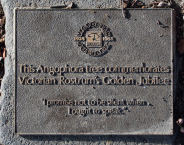
72A6
This picnic shelter is a joint project of the ROTARY CLUB OF GLEN WAVERLEY AND MELBOURNE PARKS & WATERWAYS
Original concept and design by MELBOURNE PARKS & WATERWAYS
Constructed and financed by ROTARY CLUB OF GLEN WAVERLEY
Officially opened March 1st, 1996
Placed to commemorate the joint project by Rotary club of Glen Waverley and Melbourne Parks & Waterways to erect a public picnic shelter.
Rotary Club of Glen Waverley:
Founded in 1972 through the sponsorship of the Rotary
Club of Waverley. The club began with 34 foundation
members, with Bill Pratt as the Club President. The
Village Green Hotel was the venue for the foundation
meeting and has been the venue for all meetings since,
apart from a short period of time when the hotel
underwent extensive renovations.
The club members have funded and organised many projects, such as the transport and restoration of a relocated old house to the Glen Waverley Secondary Collage Camp at Nayook, built and furnished CARA (a house for young girls), and the construction of an Abbeyfield house, (a residence for elderly people). The club has also built three shelters at Jells Park and has hosted a number of exchange students from around the world. The club has also sponsored secondary college students to attend the National Youth Science Forum and the Model United Nations Assemblies and has supported many other community activities.

70K3
Scotchmans Creek Linear Park
A Bicentennial Commemorative Project
Development of this section of Linear Park
Was jointly funded by the Commonwealth,
Victorian and Local Governments.
Project Management Construction Agency
City of Waverley
AUSTRALIA'S BI-CENTENNARY, 1788-1988.
Note: 12/3/2008.
The plaque is set into a honeycomb rock and faces
south-west, close to the eastern footpath.
The Blackburn Rd to Waverley Rd section of the Linear Park, following Scotchmans Creek was completed as part of the 1988 Bicentennial celebrations.
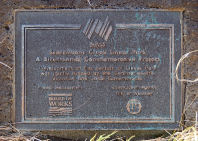
Note: 13/2/2008
Located in front of Contessa Receptions.
70A3
THE SCOTCHMAN'S CREEK RUN, 1840
In January 1840, John McMillan, the Scotchman, leased 5 square miles of country, (1,296 hectares) around the creek which drains into that part of Gardiner's (or Allen's or Kooyong Koot) Creek flowing through the north-west corner of Waverley. Historian Susan Priestly, described The Scotchman's Creek Run (1840) "Begin on the creek where it comes closest to Dandenong Rd at Oakleigh, the line would go along Dandenong Rd to Wellington Rd to Springvale Rd, north along Springvale Rd - to Waverley Rd and back along Waverley Rd to the high ridge above the creek."
The rolling country with "good pasture, moderately timbered with gum and box" soon nurtured many runs such as "Corhanwarrabul", "Tirhatuan", "Bushy Park" and "Allen's Creek". In 1894, the banks of Scotchman's Creek were damaged by gold diggers and later by highway and freeway.
Placed as part of the Victoria 150 celebrations in the City of Waverley, by the students of Wesley College, Spring, 1985.
VICTORIA 150 CELEBRATIONS
Note: 6/3/2008:
The plaque contains an incorrect spelling of Priestley.
Historical note,
8/3/2008:
John McMillan leased, in January 1940, five square miles
of land around Scotchman's Creek. This was later sold to
a Dutchman named Van Amstel.
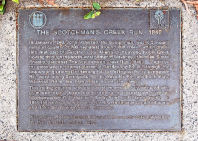
"SYNDAL"
Sir Redmond Barry, KCMG, Chief Justice of Victoria named the property, 'Syndal' and lived here from 1869 - 1880. Syndal was developed as a country estate producing many fruits, herbs, flowers, vegetables and grapes, eventually giving its name to the area.
Placed as part of Victoria 150 celebrations in the City of Waverley, by the students of Syndal High School, Autumn, 1985.
Historical note
13/2/2008:
From July 1869, Sir Redmond Barry planted fruit trees and
vegetables on this estate thus becoming one of the
pioneer orchardists in the area. The name
"Syndal", meaning sunny dale, was another of
the legacies he left to Waverley.
It is doubtful if it could be said the Barry "lived here". It is more likely that he stayed on the property for some period of time on numerous occasions.
Note: Located in front of "The Oaks" residential development (formerly the Colman property), 547 High Street Rd, 100 metres west of Lawrence Rd.
Historical Note,
9/6/2008:
Redmond Barry (1813–1880)
Sir Redmond Barry is perhaps the best known of Melbourne’s early legal practitioners. Although he neither studied nor taught at the University of Melbourne, he was a central figure in the University's early history.
Barry was born in Ireland in 1813. He graduated from Trinity College, Dublin, and was admitted to the Irish Bar in 1838.
Arriving in Melbourne in 1839, Barry was soon an active member of Melbourne’s legal community. He was appointed Solicitor General of the newly founded colony of Victoria in 1851 and Judge of the Supreme Court of Victoria in 1852. He was the judge at the trial of Ned Kelly in 1880.
Barry also had a key role in the creation of some of Melbourne's oldest cultural institutions, including the State Library of Victoria, the National Gallery of Victoria and the University of Melbourne. As the University's founding Chancellor, he took the leading role in the establishment of its first law course in 1857.
Barry died in 1880 and is buried near the University, in the Melbourne General Cemetery.
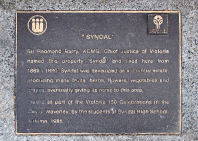
71C5
ST. LEONARD'S CATHOLIC CHURCH, 1913.
This plaque commemorates the site of the first St. Leonard's Catholic Church in Glen Waverley, 1913.
Placed as part of the Victoria 150 celebrations in the City of Waverley by the students of St. Leonard's Catholic Primary School, Autumn, 1985.
VICTORIA 150 CELEBRATIONS
Historical note,
10/2/2008:
St. Leonards was opened as a country outpost of the
Oakleigh parish. Built in 1913, the building was
later moved in 1956, north, along Springvale Rd to the
site of the new St Leonard's Centre.
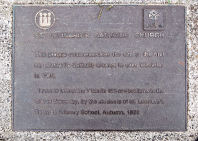
61D11
ST. STEPHEN'S CHURCH, MT. WAVERLEY
Designed by Nathaniel Billing and built by William Weir with bricks baked from local clay by William Stevenson, it was licensed by Bishop Perry 9/7/1865, and opened for divine service 23/7/1865, the first service being conducted by Rev. T.C. Cole. A Common School was established, 1866-7.
Placed as part of the Victoria 150 celebrations in the City of Waverley, by the students of Ashwood High School, Autumn, 1985.
VICTORIA 150 CELEBRATIONS
Historical note,
13/2/2008:
This was the first church built in Waverley and is now
the oldest standing church building in Waverley. It is
built from hand-made bricks and contains a memorial
window (1914-1918). This now known as St. Stephen &
St Mary following the incorporation of the St Mary's
Parish.
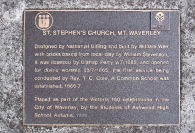
71J8
WHEELERS RIDGE
This plaque was placed here on
2nd October, 1973
by
John Aubrey Stott
To honour the pioneering owners
of this property
1854 – 1973
Placed to mark the ownership of the surrounding land by Sidney T. Stott.
Stott was the owner of Stott's Business School, Melbourne.
This large property was bought by Sidney T. Stott from John Wheeler in 1854 - in total, 246 acres and was named "Elinora". In 1916, Sidney Stott planted 100 acres with 10,000 fruit trees apples with 7000 being various varieties of apples and 2000 being pear trees. After returning from WWI, his son, Aubrey improved on the orchards using early mechanised means, such as tractors, a grader and high powered pumps. He also built a large cool store on the property and employed modern methods to obtain heavy cropping.
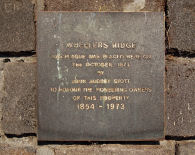
61E1
SYNDAL PRIMARY SCHOOL
I.D. HISLOCK AND A.C. RAPHAEL
ART AND CRAFT CENTRE
THIS CENTRE WAS ERECTED BY THE PARENTS AND FRIENDS OF THE SCHOOL IN CONJUNCTION WITH THE EDUCATION DEPARTMENT, AND WAS OFFICIALLY OPENED ON 28TH DAY OF JULY, 1970, BY MR. F.H. BROOKS, M. SC., DIP. ED., F.R.A.C.I., F.A.C.E., DIRECTOR-GENERAL OF EDUCATION.
Placed originally when the school's Art and Craft Centre was officially opened in 1970.
This plaque was removed from the school when it was closed and forwarded to Waverley Historical Society for storage and safekeeping.
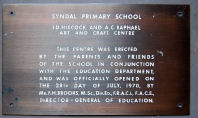
61E1
Located originally inside the school library building to mark the opening of the library in 1965.
This sign was removed from its original location and placed in the care of Waverley Historical Society.
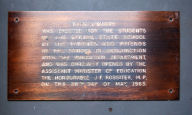
Note, 14/2/2008: Located on the traffic island between the south bound lane of Stephensons Rd and the carpark. Midway between Waimarie Drive and The Highway.
This current location is approximately 100 metres south of the actual site of the store which is where the Christian Science Reading Room now is.
70E1
TAIT'S STORE
The site of the first Post Office Store in Mt. Waverley, operated from 1906 to 1944 by Mrs. Tait and her daughters, Blair and Lily, who lived on the adjoining property, "Waimarie".
Placed as part of the Victoria 150 celebrations in the City of Waverley by the students of Huntingtower School, Autumn, 1985.
VICTORIA 150 CELEBRATIONS
Historical note,
14/2/2008:
Because the district was not allowed to have a full post
office, in 1905, Mrs. Tait who lived at
"Waimarie" in Stephensons Road was offered a
stamp-selling licence and on a 'trial basis' a loose mail
bag was taken from Mrs. Tait's on Tuesdays.
From her little store, she began stocking sweets, exercise books and pencils. Blair and Lily Tait kept the store running until 1944 and customers summoned the women from the house by ringing a small bell.
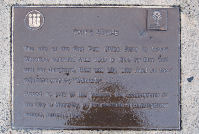
THE TALLY HO INN AND RACE TRACK
Before 1875, this district was known as Harkaway or Tally Ho. When licensee Fred Jones re-named his Inn the "Tally Ho", the settlers adopted that name in which one can still hear the echoes of their horses & hounds, & of the hunts or the paper chases when the foxes were not available. The race track, opened in 1893 and adjoining the Inn along Highbury Road, boasted a carnival meeting featuring foot and horse racing and buckjumping for some 2000 spectators on Easter Monday, 1899.
Placed as part of the Victoria 150 celebrations in the City of Waverley by the Council, Spring, 1985.
VICTORIA 150 CELEBRATIONS
Historical note,
11/12/2008:
From c.1864 there had been a store on the North Boundary
(Highbury) Road - Blackburn Rd corner diagonally opposite
the new school on the north east corner. In 1871,
Frederick Jones got a licence to open a hotel adjoining
the store.
After 1885, for a time, the Tally Ho Hotel was de-licensed but within a few years, Alexander Hunter, a builder was able to buy it. In 1890, it re-opened again.
Hunter also began the Tally Ho Race track in 1898. On Easter Monday, 1899, 2000 people turned up for the carnival.
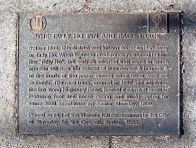
A TRIBUTE
TO THE MEMORY OF
THOMAS EVANS DOUGHTON
WHO SERVED THE
CLUB SO WELL
CAPTAIN 1929
PRESIDENT 1935 – 1947
Permission to view should be gained from Riversdale Golf Club.
Placed to honour Thomas Doughton (b. 1888) who was Captain and President of Riversdale Golf Club between 1929 and 1947.
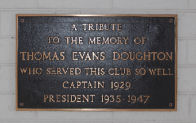
Note: 10/2/2008.
The plaque is located 20 metres to the east of the main entrance to Napier Park within an area of native plantings.
THOMAS NAPIER AND MADELINE SCOTT:
FIRST EUROPEAN SETTLERS.
Thomas Napier, a skilled builder and entrepreneur came from Van Diemen's Land to the early settlement on the Yarra.
In October 1839, he began squatting here on Dandenong Creek with cattle bought from overlanders, Watson and McLean. He built his hut somewhere in Jells Park. In 1841, he sold the run to Alexander and Madeline Scott. Alexander died soon after. Madeline, with the courage and resourcefulness typical of pioneer women, caused this run which she named "Bushy Park" to prosper, supplying meat and dairy products to the shopkeepers of Collingwood. In 1844 she sold "Bushy Park" to the Drew brothers, taking up a second leasehold on the other side of this creek.
Placed as part of the Victoria 150 celebrations in the City of Waverley, by the Council, Spring, 1985
VICTORIA 150 CELEBRATIONS
Historical note,
9/6/2008:
Thomas Napier was born in 1802 in Scotland. He was the
son of James Napier, a weaver from Montrose and Margaret
Suttor. He had a number of jobs in Scotland, working as a
clerk and training as a carpenter. He also received a
couple of years of training as an artist.
In 1832 he left Britain with his business partner John Brown (who was later to build "Como" house in South Yarra). They arrived in Hobart Town in the same year and commenced work on the construction of several buildings.
In 1836 he married Jessie Paterson, who had arrived in Hobart Town earlier that year also from Scotland.
Mr. Napier was dissatisfied with conditions in Hobart and Van Diemen's land and in 1837 sailed for the settlement at Melbourne. This was only two years after the first permanent settlement on the Yarra River by parties of settlers organised by John Batman and John Pascoe Fawkner.
When Napier arrived in Melbourne no land had yet been made available for purchase and most of the structures in the area were still temporary, constructed using "wattle and daub". In the first land sale in Melbourne he purchased a half acre allotment in Collins Street for 20 pounds. In a subsequent sale a few months later he purchased another quarter acre allotment (also for 20 pounds). He built a "wattle and daub" cottage on one of the sites and continued with his building business.
At around the same time he also settled on land in the vicinity of Jells Park on the Dandenong creek (as a "bona fide squatter"). In April of 1842 he had the misadventure of being stuck-up by two bushrangers on Dandenong Road, which was quite a novelty at that time in that location. One of the bushrangers was later shot and the other hanged.
In 1839, he "squatted" on this land but was unimpressed with the lack of pasture for his animals and sold to Alexander Scott.
Scott soon died and left his resilient wife, Madeline to look after their children and run the property which they had named "Bushy Park". After taking on partners, Mrs. Scott moved on, leaving the surviving partners, the Drew brothers to run the property.
He was not satisfied with the nature of the pasture at Dandenong and in 1845 purchased 100 acres of land on Moonee Ponds Creek from E. J. Brewster, in the area now known as Strathmore and built the house "Rosebank". Members of the Napier family lived on this land into the 1920's (apart from some lengthy overseas trips to Scotland by both Thomas and Theodore Napier).
In 1859 Thomas Napier left Melbourne for England and Scotland. He returned in 1860 however his eldest son Theodore remained in Scotland to complete his education.
Thomas Napier was made a Justice of the Peace in 1860. He also had the honour of laying the Foundation Stone of the Pascoe Vale National School (c. 1850) which was located adjacent to Moonee Ponds Creek where Five Mile Creek enters. (The Pascoe Vale National School was sold in the early 1860's and the students relocated to the new Essendon Common School in Raleigh Street, Essendon, the current site of Essendon Primary School.)
Thomas died in 1881 leaving his wife, Jessie, his son Theodore, and daughter, Eleanor Barber. Thomas Napier can truly be described as an early pioneer in the Port Phillip District and Strathmore.
On the death of Thomas Napier his land was divided between Theodore and his wife, Jessie.
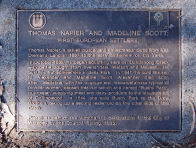
Note: 13/2/2008. Located several metres east of the High Street Road entrance to Safeway.
THE TOLL GATES
Toll gates with the toll-keepers' houses were erected on Dandenong Road in 1864, on Breakneck Road (later Waverley Road) in 1866 and at this site in 1868. The toll was expensive: variously 6 pence or 12 pence per passage. Traffic was heavy, one Dandenong Road collected £1235 ($2470), in 1870. Tolls, like any tax, were never popular, were regularly avoided or grudgingly surrendered. Toll keepers, too, were the frequent butt of practical jokes, but the extent of the road use demonstrates their importance to the community.
Placed as part of Victoria 150 celebrations in the City of Waverley, by Council, Spring, 1985.
VICTORIA 150 CELEBRATIONS
Historical note,
9/6/2008:
In January 1857, the Oakleigh and Mulgrave District Roads
Board was formed to raise money and turn theoretical
roads into practical routes for coaches and carts and
drays and bullock teams and horses and pedestrians. In
fact no one could be persuaded to stand for election to
the Roads Board until 1860. After that some progress was
made in forming roads. Mainly the Roads Board relied on
Government grants and income from the toll gates set up
along the main roads.
The local Road Board was given a share of tolls from the district and much of this was spent in collecting and burning dead trees and logs which cluttered the tracks. Travellers tried to evade the toll gates by finding tracks around them. In 1874 an Act of Parliament decreed the gradual phasing out of all toll gates and those in High Street Road and Waverley Road were dismantled in 1876.
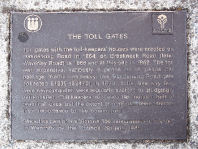
Note: 11/2/2008.
It is located adjacent to the eastern boundary fence of
Wesley College, 70 m west of Rose St.
THE TOWN COMMON : 1861 - 1906
These 65 hectares (160 acres) immediately south and west to Blackburn Road, were proclaimed common in 1861 for the townspeople's working horses, bullocks and household cows. The flat ground, a favourite picnic and sporting spot for the Muir, Seller, Pepperell and Mullens families, became in 1906 a specialist apple orchard and market garden until acquired by Wesley College, 1955 to 1959.
Placed as part of the Victoria 150 celebrations in the City of Waverley, by the students of Wesley College, Autumn, 1985.
VICTORIA 150 CELEBRATIONS
Historical note,
11/2/2008:
A town common was established in this area on the south
side of High Street Road and extending west to Blackburn
Road. It was one of several in the Shire of Mulgrave.
Here, local farmers and growers were able to rest their
horses and other farm animals.
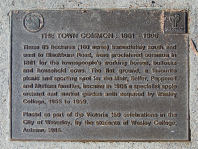
THE TOWN COMMON, 1861
Early in 1861, the town common was proclaimed on three unsold blocks: one in High Street Road on Gardiner's Creek between Huntingdale and Warrigal Roads, a second on High Street Road between Springvale and Blackburn Roads where Wesley College and the Syndal shops now stand, and this block in Waverley Road backing down to Scotchman's Creek between Forster and Stephenson's Roads. It provided for the townspeople's working horses, bullocks and household cows.
Placed as part of the Victoria 150 celebrations in the City of Waverley, by the Council, Spring, 1985.
VICTORIA 150 CELEBRATIONS
Historical note,
13/2/2008:
In addition to their own small farms the people looked to
common land to provide extra grazing for their working
animals. However, in the 1870s these blocks were sold and
John Forster obtained the title to the common land at the
corner Waverley and Forster Roads.
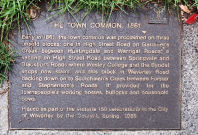
THE TOWNSHIP "WAVERLEY"
In 1864, Dr. Silverman, a Russian-born doctor purchased for £760, a quarter-mile block extending south and east from this intersection. This land he subdivided and named the "Township of Waverley", thus perpetuating his admiration for the works of the novelist, Sir Walter Scott.
Placed as part of the Victoria 150 celebrations in the City of Waverley, by the students of Mt. Waverley High School, Autumn, 1985.
VICTORIA 150 CELEBRATIONS
See also marker 31 south east corner of Charles and Portsmouth Sts, Mt Waverley.
Note:
13/2/2008.
The small, square stick-on logo for Victoria 150 has been
lost from the top right-hand corner of the plaque.
Historical note,
13/2/2008:
Dr Silverman, a Russian by birth, bought land at this
corner for 760 pound. He had arrived in 1852 and later
surveyed and subdivided his property, calling it
"Waverley" and he hoped to encourage a township
to grow here. His grand vision didn't come to pass until
much later when suburban development caught up. However,
the name "Waverley" survived in peoples' minds.
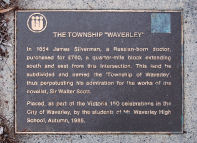
Note: 29/2/2008. The plaque is located across the footbridge, approximately 100 m. from the entrance to the park. To the left of the main access road in the park - eastern end of the bridge.
THIS BRIDGE
WAS CONSTRUCTED BY
APEX CLUB OF WAVERLEY AND
OPENED BY COUNCILLOR L. M. RYAN MAYOR,
CITY OF WAVERLEY ON 11 DECEMBER, 1977
Commemorating the opening of the footbridge over the creek within Valley Reserve.
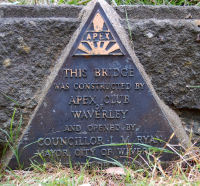
VIC ROADS
THIS PLANTATION WAS
ESTABLISHED TO COMMEMORATE
WORLD ENVIRONMENT DAY
5 JUNE 1990
Erected to commemorate World Environment Day and a stand of trees planted.
Access is only possible by stopping on the on-ramp to the freeway. There appears to be no access from the southern side of the embankment.
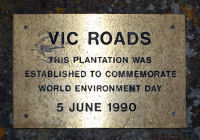
PLAQUE 1:
THIS PLAQUE COMMEMORATES THE OFFICIAL OPENING OF
VISITORS CENTRE DANDENONG VALLEY METROPOLITAN PARK
BY THE
HONOURABLE R. J. HAMER ED, MP
ON MAY 23, 1978
MELBOURNE AND METROPOLITAN BOARD OF WORKS
PLAQUE
2:
CHAIRMAN A.H. CROXFORD LLB
DEPUTY CHAIRMAN E.W. BEST CMG
COMMISSIONERS:
J.E. BOWN JP
G.R. BRICKER JP
J.K. BYRON JP
R.G. BYSOUTH JP
K.F. CHAMBERLIN JP
R.B. COMBEN JP
F.G. COX JP
P.F. DAVIES JP
D.W. BUMBRELL JP
B.S ELMS JP
F.J. FINN
F.G. FORD JP
W.J. FOSTER JP
A.M. GIBSON
A.G.E GILLON OBE, JP
D.K. GRANT JP
J.T. HARDING
M.G. HARDY
K.M.S. HOLLAND
J.B.JACKSON JP
D.C. JONES
R.F. JULIER
G.G. KERMONDE
P.T. LALOR
K.C. LEAR JP
A.A. MCCUTHEON
P.J. MCDOUGALL
R.W. MACEY
J.M. MCRAE
F.J. MADDERN
E.J. MARRIOTT
R.K MARSHALL
R.V. MEAGHER
J.W. MERCUS JP
V.R. MICHAEL JP
K.E. MILLER JP
A.E. MISSEN
K.G. MITCHELL
D.E. MUIR JP
K.V. NICHOLLS JP
W.N. OATES
G.D. O'CONNELL
A.R. PATTERSON MBE, JP
L.F. PAYNE OBE, JP
D. QUADARA
K.A.F READWIN
J.D. RYAN, JP
N.W. SMITH JP
W.H. TEW MBE, JP
W.R. WALTERS MBE, JP
I.G.N. WARNER
B.F WATERS
R.D. WHITE, JP
B.T. ZOUCH, JP
MAY 23, 1978
PLAQUE
3:
INAUGURAL DANDENONG VALLEY METROPOLITAN PARK
ADVISORY COMMITTEE
MEMBER REPRESENTING
COMMISSIONER L.F. PAYNE (CHAIRMAN) MMBW PLANNING COMMITTEE
COMMISSIONER
P.F. DAVIES MMBW PLANNING COMMITTEE
COMMISSIONER W.H. TEW MMBW PLANNING COMMITTEE
MR. R.D. EGAN-LEE CITY OF KNOX
MR. J. HALFORD CITY OF WAVERLEY
MR. W. STEWART CITY OF NUNAWADING
MR. D.P. GAWLER CITY OF NUNAWADING
MR. A.C. ROBERTSON CITY OF RINGWOOD
MR. T.S.L. STITT CONSERVATION COUNCIL OF VICTORIA
MR. D. POWNEY DEPARTMENT OF YOUTH, SPORT AND RECREATION
MR. S.W. CALDER FORESTS COMMISSION OF VICTORIA
MR. A.M. COONEY MINES DEPARTMENT
MR. D. THOMPSON DANDENONG VALLEY AUTHORITY
MR. B. PEYTON COUNTRY ROADS BOARD VICTORIA
MR. H. G. THORPE STATE ELECTRICITY COMMISSION OF
VICTORIA
MR. G.P. HAYES MEMBER OF PARLIAMENT
MR. D.W. SIMPSION MMBW
MR. K. RASMUSSEN MMBW
MR. T. ARTHUR MMBW
Historical
note, 9/6/2008:
Jells Park is at the hub of a network of parklands linked
by the Dandenong Creek. Nestled in the heart of suburbia
the park is abundant with native plants and wildlife and
is a diverse recreation destination for the whole family
- you can experience it all in Melbourne's backyard.
With over nine km of paths and trails, hectares of wide open spaces and picnic areas for everyone to enjoy.
Named after one of the first pioneer settlers in the area, Joseph Jell, the park has had an interesting history, being used for grazing, a piggery and even a storage area for the American Army during World War 2. Prior to European settlement, Aborigines from the Woiworung and Bunurong tribes lived on the land for over 30,000 years.
Jells Park was officially opened in April 1976 and is now one of the most popular parks in Melbourne catering for over 700,000 visitors
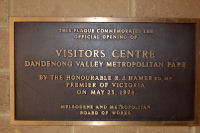
WAVERLEY NORTH STATE SCHOOL
THIS LIBRARY WAS ERECTED BY THE PARENTS AND FRIENDS OF THE SCHOOL IN CONJUNCTION WITH THE EDUCATION DEPARTMENT, AND WAS OFFICIALLY OPENED ON 26TH SEPTEMBER 1969
BY THE HON. L.H.S. THOMPSON. M.L.C., MINISTER OF EDUCATION.
Originally placed on the wall of the school's library when it was opened in 1969. The plaque was removed when the school was closed and the library was demolished. It was subsequently placed in the care of Waverley Historical Society.
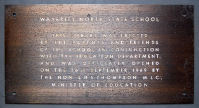
THE WESLEYAN CHURCH, BLACK FLAT
Site of the original Black Flat Wesleyan (later Glen Waverley Methodist) Church 1887-92 (used also as original Black Flat School) on land donated by James Colley, Class Leader.
Placed as part of Victoria 150 celebrations in the City of Waverley, by the students of Brentwood High School, Autumn, 1985
VICTORIA 150 CELEBRATIONS
Historical note,
17/11/2008:
James Colley was one of a number of settlers who bought
land at Black Flat in the 1050s. By 1864 he was leader of
a group of 12 Wesleyans nearby. In 1866, he first
suggested that a meeting hall be built but it took over a
year to gain permission from the Wesleyan circuit and
then only if it cost less than 10 pounds to build! A
small chapel with a shingle roof was in use as a school
which became the focus of the district. It became a State
School in 1872, until the new brick school was built and
ready for use in 1880.
The small weatherboard chapel was the focus of community life and worship for many years until a new church was built in Springvale Road, at the corner of Kingsway in 1962.
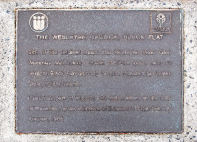
61E10
40 year Commemoration
On 26th September, 1988, a group of
concerned Waverley residents met and formed
"The Damper Creek Conservation
and Development Group"
their efforts helped preserve this bushland reserve
for future generations.
Erected in November, 2008 in recognition of their efforts
by the Friends of Damper Creek Reserve Inc.
The official dedication ceremony held at the site was on Sunday 30 Nov, 2008
Note re: F.O.D.C. Inc, 8/12/2008:
Damper Creek was probably a valuable food source for the
traditional inhabitants of the area, the Wurundjeri.
Later it was a rest place and water source for stockman.
Damper Creek Reserve played a small part in the building of St Stephen's Anglican Church in High Street Rd, Mt Waverley. The plans for the church were drawn up in 1864 and donations were requested to pay for the building. The congregation contacted a William Stevenson (Stephensons Road, a variation, was named after him), to bake the bricks and he obtained his clay from the crossfire of gullies around Damper Creek. The bricks were fired in a kiln built near the creek and the church members carried them up the hill.
Orchards, market gardens and farms soon surrounded the creek until after World War 2 when the city began to spread eastward.
Damper Creek and the surrounding bushland was saved by local residents from subdivision and road construction in 1969. Several local Councillors were elected on the platform of preserving the creek for public open space.
Urban development surrounded the Damper Creek "drain" and the area was infested with blackberries, ivy and other noxious weeds. Willow trees elevated the creek bed and the banks were eroding with the increasing volume of stormwater. The area was used as a dump for local resident's garden refuse and rubbish.
In the early 1990's circuit fitness equipment was put into the reserve but the area was often too boggy and not an attractive or safe place to run.
Bushland Restoration
Project:
The Friends of Damper Creek Reserve was formed in April
1993. The Friends worked in conjunction with the then
City of Waverley (now Monash Council) to begin a staged
restoration of the creek.
The Council began the major engineering component to stabilise and reconstruct the creek bed and banks, while the Friends successfully applied to Melbourne Parks and Waterways (now Parks Victoria) for funding for plants. As well as planting and the general maintenance weeding the Friends have constructed the middle bridge known as "Palma's Plummet" and the boardwalk over the Bengal Crescent Tributary, put in the two noticeboards, erosion control sleepers, bench seats, fencing and the aquatic ponds in the compound.
The basalt rockwork in Damper Creek is not indigenous to the area but was chosen to stabilise the creek and as an attractive landscaping feature. Claystone is the indigenous rock, hence the history of brick making in the area.
The restoration work has occurred from Stephensons Rd to the junction with Damper Creek East near Alvie Hall. The project is now up to Stage 8 which terminates at the Riversdale Golf Course. In the future, restoration works may also occur along the remainder of Damper Creek East behind the Bowls Club and in Bellbird Corner (corner High Street Rd and Stephensons Rd, Mt Waverley).
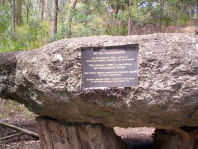
71C3
Sir John Monash
Cast from the original mould commissioned by the State Electricity Commission and presented to the City of Waverley by SEC Victoria in August 1996
Historical Note, 19/12/2008:
General Sir John Monash
The City of Monash is named after a man regarded as one of Australia's greatest heroes. General Sir John Monash was a civil engineer and volunteer soldier who rose to the highest rank in the Australian Army by the end of World War 1.
His life and career represent the opportunity that Australia provides for migrants and their children to excel and contribute. He is a model of leadership, community service, and achievement for everybody living and working in the City of Monash today.
The Young Man
John Monash was born in West Melbourne in 1865 to immigrant Prussian parents, when the Victorian Colony was barely 30 years old and the population was just 40,000.
Monash's was one of the first Jewish families who arrived in Australia seeking refuge from terror, discrimination and poverty in Europe. In Melbourne, Jews had no work prohibitions. They entered Parliament in significant numbers, and they had educational opportunities and social freedom.
John Monash's story represents the extraordinary fortune of Australian Jewry.
Monash's father took the family to Jerilderie, N.S.W in 1875 to open a general store. This is possibly where the young boy began his life long appreciation for the Australian landscape and for the 'down to earth spirit' of the locals. Contrary to a story that he neither confirmed nor denied, Monash was not in Jerilderie in February 1878 when the Kelly gang came and terrorised the community and raided the bank vault. Monash may have held the Bushranger's horse on a previous occasion, but by 1878 he had returned to Melbourne with his mother and sisters to go to school. The suggestion that two of Australia's most famous personalities met is an intriguing historical possibility.
Monash was scholarly and particularly talented at mathematics. He matriculated at 14 and two years later he was equal Dux of Scotch College. At the University of Melbourne he studied Law, Engineering and Arts and became involved in broader cultural activities, such as debating, politics, theatre and journalism.
He co-founded the Melbourne University Union. Monash also painted and spoke French and German. He enjoyed chess, carpentry and bushwalking and was an accomplished pianist.
When his mother was dying he discontinued his studies to support his family and worked on the construction of Princes Bridge over the Yarra River. He eventually completed his university studies and in 1888 he assumed responsibility for construction of the Outer Circle railway, which terminated at Oakleigh. He also purchased property in the district beside the railway line.
In 1891 he married Hannah Victoria Moss, a charismatic woman with whom he had a turbulent relationship. They had one daughter, Bertha, two years later.
The Engineer
In 1891 Monash was employed by the Melbourne Harbour Trust and was retrenched during the 1894 depression. He then developed an enterprise with J.T. Noble Anderson specialising in civil, mining and mechanical engineering and patents. In 1905 Monash and associates formed Reinforced Concrete and Monier Pipe Construction Co Ltd.
This company developed an expertise in reinforced concrete construction, yet another innovation that he embraced. Monash first faced failure, and then success, as a bridge builder, and as the director of a major concrete construction company.
The Soldier
Monash's time in the military began while at university,
when he joined the 4th Battalion, Victorian Rifles. He
was a volunteer, not a professional soldier. He rose
through the ranks of the Militia, the reserve army.
At the outbreak of World War 1 he became the Chief Censor before taking command of the 4th Infantry Brigade. His career included command in Egypt and the landing at Gallipoli.
In France his unit played a significant role in breaking through enemy lines in 1918 at Amiens, and was decisive in the victories at the battles of Villiers-Bretonneux and Hamel which involved the collaboration of infantry, artillery, tanks and aircraft. Monash was credited with the success of the August 8 offensive on the Western Front, regarded as the crucial battle of World War 1. In a rare gesture by King George V he was knighted in the field in 1918.
As a military strategist General Monash was way ahead of his time.
His approach was innovative and modern, informed by his civilian experience and training. His guiding principle was to avoid needless loss of life, and his motto was to "feed the troops on victory". He followed it literally arranging for hot meals to be delivered to his men during battle.
Monash remained in Europe at the end of the war and, as Director General of Repatriation and Demobilisation, efficiently managed the repatriation of 160,000 Australian soldiers. He organised professional and trade skills training for the repatriated soldiers.
By the time he returned home to a tumultuous welcome at the end of 1919, he was respected by senior Allied military men and politicians, and was feted by the public. He attracted criticism from traditionally minded officers, but won the approval of his men and commanders who worked closely with him. He had distinguished himself as a fine administrator with a genius for strategy.
The Statesman
After World War 1, Monash returned to his engineering
business.
He became restless and sought a public role, eventually becoming Chairman of the State Electricity Commission as it began to mine coal and generate electricity from Victorian sources.
In the 1920s he was Australia's most revered public figure. He enjoyed the status and responsibility his career brought him. He knew his was an unusual position for a Jew. General Monash led many ANZAC parades and was the driving force behind the building of the Shrine of Remembrance in Melbourne.
He lectured at the University of Melbourne and was its Vice-Chancellor for two years from 1923. Monash became the President of the Australian Association for the Advancement of Science. He was also President of the Victorian Institute of Engineers and active in the Boy Scout movement.
Family was important to him, and in retirement he spent time with the younger generations at the family home, Iona. He died on 8 October 1931, at the age of 66, and an estimated 250,000 mourners attended the state funeral to pay their respects.

71C3
Novotel
Glen Waverley
Officially opened by
THE HON. LOUISE ASHER, M.P.
MINISTER FOR SMALL BUSINESS AND TOURISM
ON
Wednesday 27th July, 1998
ACCOR
Note, 19/12/2008:
Novotel Melbourne Glen Waverley is owned by AAPC
Properties Pty Limited which is a wholly owned subsidiary
of AAPC Limited. AAPC Limited is ultimately owned by
Accor SA, a company listed on the French stock exchange,
a worldwide leader in travel, tourism and corporate
services. AAPC Limited directly or through its
subsidiaries, including AAPC Properties Pty Limited
operates in Australia under the business name Accor.
They operate hotels under the Accor brand, co-branded with such brand names as Sofitel, Novotel, Mercure, All Seasons, Ibis and Formule 1.

71C3
MONASH UNIVERSITY REGIMENT
Presented to the
Mayor,
Councillors and Citizens of the City of Monash
by the Commanding Officer and all ranks of the Monash
University Regiment
on the occasion of the Regiment exercising its Right of Freedom of Entry to the City of Monash on 28 February, 1998
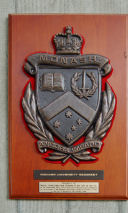
71C1
WAVERLEY CIVIC CENTRE
OFFICIALLY OPENED 22ND NOVEMBER, 1984
ACHIEVEMENT OF THIS PROJECT IS ATTRIBUTABLE TO A TEAM EFFORT
OF COUNCILLORS, ESPECIALLY MEMBERS OF THE CIVIC CENTRE SUB-COMMITTEE, OFFICERS AND CONSULTANTS.
CIVIC CENTRE
SUB-COMMITTEE
THE COMMITTEE FIRST MET 26TH MAY, 1981 AND SERVED UNTIL
1ST AUGUST, 1985.
ITS CONTINUING MEMBERS BEING CR. V.P. LeGRAND (CHAIRMAN) AND CRS. G.B. FRECKER, R.D. HANNAN,
N.R. HUTCHINSON-BROOKS AND L.M.RYAN.
COLIN J. BOCK A.G. THOMPSON
TOWN CLERK CITY ENGINEER
J.N. WEBSTER
- DEPUTY TOWN CLERK
J.N. HALFORD - DEPUTY CITY ENGINEER
R.J. McNAMERA - SPECIAL PROJECTS MANAGER
PRINCIPAL CONSULTANTS
HARRY SEIDLER
& ASSOCIATES ARCHITECT CIVIL AND
CIVIC PTY. LTD. PROJECT MANAGER
THESE ACKNOWLEDGEMENTS ARE NOT AN EXHAUSTIVE LIST FOR IT
WAS THE CONTRIBUTIONS OF ALL COUNCILLORS AND ALL STAFF
OVER NEARLY A DECADE WHICH STEERED THE PROJECT FROM
CONCEPTION TO SUCCESSFUL COMPLETION.
Note, 19/12/2008:
Design/Completion 1982-1984, Waverley, Victoria
City of Waverley
3,500 sq m
Concrete structure, split concrete blockwalls RAIA Award, 1985
The Local Government complex stands on beautifully landscaped gently sloping ground.
A two storey wing contains the new council chamber, mayor's office, council facilities, function and meeting spaces. A three storey wing, houses the new council offices. Between them is the high central atrium foyer which can on occasions be used for large gatherings, art shows and exhibitions.
A ramp leads up from the lower entry to a freestanding elevator and an open stair which gives access to all departmental offices. A suspended bridge across the entry space connects the council chamber and its ancillary public spaces with executive offices.
The most distinctive element in the new complex is the shape of the skylight roof over the council chamber. It consists of two opposing quadrant-shaped concrete walls forming a semicircular vault which allows overhead daylight to enter the otherwise windowless chamber.
Supported on a single column standing in a circular reflecting pool, the council chamber forms the main silhouette of the building.
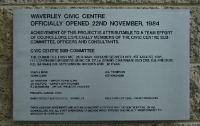
71C3
THE WAVERLEY CIVIC CENTRE WAS OFFICIALLY OPENED
BY HIS EXCELLENCY THE GOVERNOR OF VICTORIA
REAR ADMIRAL SIR BRIAN MURRAY, K.C.M.G., A.O.
ON THE TWENTY SECOND DAY OF NOVEMBER 1984
COUNCILLORS
D.W. APPLETON J.P.
G.B. FRECKER R.D. LYDON
R.D. HANNAN D.R. OLIN
T.M. HERRERNAN I.M. PEDERICK
N.H. HUTCHINSON-BROOKE L.M.RYAN J.P.
V.P. LE GRANDE E.M. STURROCK
A.G.
THOMPSON L.G.E F.I.E. AUST.
COLIN J. BOCK F.I.M. J.P.
CITY ENGINEER TOWN CLERK
Note, 19/12/2008:
Design/Completion 1982-1984
Waverley, Victoria
City of Waverley 3,500 sqm
Concrete structure, split concrete blockwalls RAIA Award, 1985
The Local Government complex stands on beautifully landscaped gently sloping ground.
A two storey wing contains the new council chamber, mayor's office, council facilities, function and meeting spaces. A three storey wing, houses the new council offices. Between them is the high central atrium foyer which can on occasions be used for large gatherings, art shows and exhibitions.
A ramp leads up from the lower entry to a freestanding elevator and an open stair which gives access to all departmental offices. A suspended bridge across the entry space connects the council chamber and its ancillary public spaces with executive offices.
The most distinctive element in the new complex is the shape of the skylight roof over the council chamber. It consists of two opposing quadrant-shaped concrete walls forming a semicircular vault which allows overhead daylight to enter the otherwise windowless chamber.
Supported on a single column standing in a circular reflecting pool, the council chamber forms the main silhouette of the building.

Not in its original place.
71C3
THESE BUILDINGS
WERE OPENED AND DEDICATED BY
THE REV. STANLEY I. WEEKS M.A.,
PRESIDENT OF THE CONFERENCE
ON THE OCCASION OF THE 98TH ANNIVERSARY
OF THE METHODIST CHURCH IN GLEN WAVERLEY
SUNDAY 12TH AUGUST, 1962.
MINISTER:- THE REV. ANGUS C. ALLINSON
ARCHITECT
BUILDER
F.C.
ARMSTRONG
F.H. JENNINGS
A.R.I.B.A. A.R.A.I.A.
To commemorate the opening of the original Methodist Church in 1962. This plaque may be viewed by approaching the church office on entry.

Not in its original place.
71C3
TO THE GLORY OF GOD
THIS EXTENSION WAS COMPLETED
DECEMBER 1982
REV. IAN PARTON MINISTER
To commemorate the extensions to the church buildings in 1982. This plaque may be viewed by approaching the church office on entry.

Not in its original place.
71C3
TO THE GLORY OF GOD
THIS STONE WAS UNVEILED BY
MRS. G. STEWART TAYLOR
ON THE 7TH JUNE, 1964.
REV. A.R.C. JAMIESON : MINISTER
It was probably taken from the original Methodist church building.
This plaque may be viewed by approaching the church office on entry.
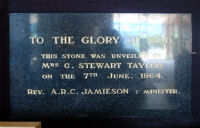
71C3
TO THE GLORY OF GOD
THIS STONE WAS
LAID BY
MRS. M.R.E. HOLLAND
28TH APRIL
1956
REVD. G. STEWART TAYLOR B.A., B.D.
MINISTER
KEITH
REID
E.C. BUTLER
ARCHITECT
BUILDER
The stone was probably taken from the original Methodist church building. This plaque may be viewed by approaching the church office on entry.
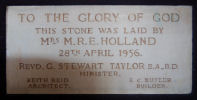
71C3
TO THE GLORY OF GOD
THIS STONE WAS LAID BY
THE REV. STANLEY I. WEEKS, M.A.
PRESIDENT OF
THE CONFERENCE
20TH MAY 1962
The stone was probably taken from the original Methodit church building. This stone may be viewed by approaching the church office on entry.

71C3
THIS CHURCH CENTRE
WAS OPENED AND DEDICATED
TO THE GLORY OF GOD
FOR THE MISSION OF THE CHURCH
ON 1ST DECEMBER 1991
BY THE MODERATOR
REV. JOHN BILLINGTON
AND THE PRESBYTERY
OF MAROONDAH
MINISTER REV. IAN SMITH
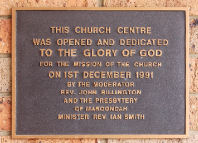
71C3
IN MEMORY
OF
JOHN B. ALABASTER
LOVED ELDER OF THIS CHURCH
AGED 43
10-3-1934 26-5-1977
DEVOTED MEMBER FOR 21 YEARS
Dedicated to John B. Alabaster. This plaque may be viewed by approaching the church office on entry.
Historical note, 19/12/2008:
Monash City Church of Christ, formerly known as Glen Waverley Church of Christ, recently celebrated its 50th Anniversary with a large celebration held at its Montclair Ave location.
The Church which was founded by members of the Oakleigh Church of Christ, began its life in the home of the Thoheys in Glen Waverley, but soon out grew this location, and in 1954 began worshiping in a Tent, erected in Little street. The Church moved to its current location in 1955, when the first chapel was opened and dedicated.
ver the years, the building has under gone many changes with the current facilities being opened in 1990, which gave the community an enlarged auditorium, more office space and also allowed for the expansion of the New Horizons Bookshop and Coffee Shop which opened in the early 1980's.
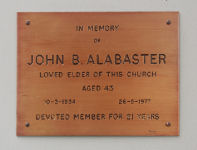
62G12
LEGEND PARK TENNIS CLUB 18TH JUNE 1974
A PUBLIC MEETING INITIATED BY BERYL POLHILL
AND HELD ON THE ABOVE DATE LED TO
THE OFFICIAL CLUB FORMATION 28-11-1974.
COURTS OPENED 22-8-1976
BY CR.PERRY, J.P. MAYOR, CITY OF WAVERLEY
CLUB HOUSE OPENED 11-2-1979
BY CR. J.J. TAYLOR J.P.M MAYOR OF WAVERLEY
THIS PLAQUE WAS UNVEILED CR.G.B. FRECKER J.P.
AT THE TENTH ANNIIVERSARY CELEBRATIONS JUNE 1984
Erected and dedicated to commemorate the tenth anniversary of the opening of the tennis club and four-court complex in the clubrooms.
Access can only be when members are in attendance at the club rooms.

71H1
THIS BUILDING
WAS DEDICATED
AND OPENED
TO THE GLORY OF GOD
BY
COMMISSIONER
DONALD CAMPBELL
27TH OF NOVEMBER, 1987
EVA
BURROWS
DONALD CAMPBELL
GENERAL
TERRITORIAL COMMANDER
Erected to commemorate the opening of the Salvation Army Temple and complex in 1987.
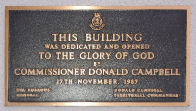
THIS FOUNDATION STONE
WAS LAID BY
COMMISSIONER DAVID C. LAMB
(INTERNATIONAL
SECRETARY, LONDON)
ON WEDNESDAY AUG. 20TH 1913.
BEING THE
FIRST ANNIVERSARY OF THE DEATH OF
GENERAL WILLIAM BOOTH
"EVERY HOUR AND EVERY POWER
FOR CHRIST AND DUTY".
WM. BRAMWELL
BOOTH,
JAMES HAY,
GENERAL
COMMISSIONER
This foundation stone was not initially part of Mulgrave Waverley Monash history, but is kept and permanently displayed by Glen Waverley Salvation Army Corps at their temple.
It was originally the foundation stone for the Corps building in Burwood Rd Hawthorn and was brought to Waverley on the establishment of the temple in 1987.
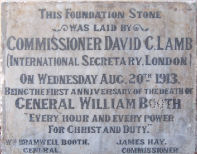
62G12
ERECTED BY THE MEMBERS OF
LEGEND PARK TENNIS CLUB
TO HONOUR THE MEMORY OF
WINSTON BELL
FOR HIS
DEDICATED SERVICE TO
THE CLUB OVER MANY YEARS
OCTOBER 1993
Access can only be when members are in attendance at the club rooms.

72A6
This picnic shelter is the project of the
ROTARY CLUB OF
GLEN WAVERLEY AND
PARKS VICTORIA
Original concept and design by
PARKS VICTORIA
Constructed and financed by
ROTARY CLUB OF GLEN WAVERLEY
officially opened March 23rd 1998.

72A6
IN MEMORY
OF
GEOFF ALPER
"Service above Self"
Rotary club of Glen Waverley
Year 2000
Rotary Club of Glen Waverley:
Founded in 1972 through the sponsorship of the Rotary Club of Waverley. The club began with 34 foundation members, with Bill Pratt as the Club President. The Village Green Hotel was the venue for the foundation meeting and has been the venue for all meetings since, apart from a short period of time when the hotel underwent extensive renovations. The club members have funded and organised many projects, such as the transport and restoration of a relocated old house to the Glen Waverley Secondary Collage Camp at Nayook, built and furnished CARA (a house for young girls), and the construction of an Abbeyfield house, (a residence for elderly people). The club has also built three shelters at Jells Park and has hosted a number of exchange students from around the world. The club has also sponsored secondary college students to attend the National Youth Science Forum and the Model United Nations Assemblies and has supported many other community activities.
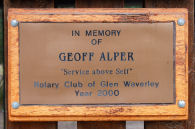
72A6
This picnic shelter is a joint
project between the
Rotary Club of
Glen Waverley
and Parks Victoria.
Original
concept and design by Parks victoria
Constructed and financed by the
Rotary Cluub of Glen Waverley.
Officially opened 24 May 2000.
Rotary Club of Glen Waverley:
Founded in 1972 through the sponsorship of the Rotary Club of Waverley. The club began with 34 foundation members, with Bill Pratt as the Club President. The Village Green Hotel was the venue for the foundation meeting and has been the venue for all meetings since, apart from a short period of time when the hotel underwent extensive renovations.
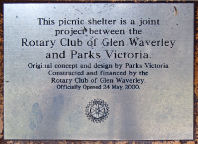
This Mural and Sustainable Garden
has been proudly sponsored by
CVGT Employment and Training Specialists
through the Work for the Dole initiative with the support
of Amaroo
Neighbourhood House.
This site was
officially recognised
on
March 21st 2005
by
Senator Tsebin Tchen
Work for the
Dole
An Australian Government Initiative
"Work for the Dole is a Commonwealth Government
Initiative"
THE WORK FOR THE DOLE SCHEME,
In February 1997 the Howard Government announced its intention to amend social security legislation to introduce a scheme whereby unemployed young people would be required to engage in part-time work in order to be eligible for unemployment benefits. There will be a mix of compulsory and voluntary work although it has been stated that social security payments could be cut to those who refuse to comply with the scheme. The Government has decided that young people will be paid award wages and therefore they will only work the hours required to get unemployment allowance payment. Participants will still be required to look for full time work and unless employed full time will be registered as unemployed.
Work-for-the-dole projects:
Sustainable garden project
The gardens of a number of older Neighbourhood Renewal residents have been redesigned by Ashburton Support Services. The service has provided drought tolerant plants, mulch and design layout.
AMAROO NEIGHBOURHOOD CENTRE:
Amaroo Neighbourhood Centre provides programs, activities, support groups, child care, health related programs, learning and recreational programs and one-off workshops, and aim to keep all our activities as low cost as possible. We have the services of a large op-shop that provides goods and clothing at very reasonable prices, we also have an annual art show and host the local Neighbourhood Watch Group. All programs are integrated for persons with a disability where appropriate. We are managed by a committee of management and new members are always welcome.
Waverley Adult Literacy are also housed in Amaroo Neighbourhood House and offer a variety of programs such as ESL classes, computer classes etc
Historical Note, 7/1/2009:
Amaroo Neighbourhood House was established on the site of a house, "Wattle Grove" which was, for many years the home of the farming Colwell Family. It was burnt down c.1950. In 1966, the Malvern Corps of the Salvation Army built a hall there. In 1981, Waverley Council purchased the property from the Salvation Army and established a Neighbourhood House, Op Shop and food bank in the building.
Historical note,
7/1/2009:
SENATOR TSEBIN TCHEN.
Tsebin Tchen was our first Chinese-born federal
politician.
He was elected in 1998 from the difficult third spot on the Liberals' Victorian Senate ticket, thanks mainly to Jeff Kennett, his state's flamboyant premier at the time, who used his influence to get Tchen preselected ahead of a sitting Liberal senator. When the preselection was held, Tchen proved successful by a comfortable margin and in due course, after a rather more strenuous effort in the election itself, became the first Asian migrant to win a seat in either house of the federal parliament.
But then in late 2004, Tchen was un-elected. That is, colleagues convinced him the Liberal Party would withdraw its support if he sought a second term in the general election of that year.
So Tchen, rather than embarrass his party as well as himself, withdrew his nomination. Thus his six-year term ended on June 30, 2005 and so did his political career.
In spite of his rather turbulent introduction, Tchen performed quietly in parliament. He served on a large number of committees, performed electoral duties energetically, and on the floor of the senate was often seen but more rarely heard. He was a strong advocate of multiculturalism but with a forcefully positive approach: with the emphasis on seeking common purposes rather than identifying differences, and of demanding acceptance rather than just tolerance. As chair of the government members' policy committee on immigration and multicultural affairs between 2000 and 2004, an elected rather than a nominated position, Tchen had an unpublicised, but nevertheless of some influence, role to play as Australia tried to grapple with the vexing issues of asylum seekers and boat people.
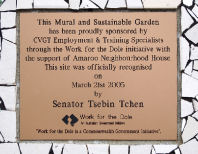
60H2
CITY OF MONASH
Aerosol Art Project
This mural has
been proudly sponsored by the City of Monash and
produced by the Activate youth Group
with the guidance of Christie Allison under the auspices
of Amaroo Neighbourhood Centre Inc.
This mural was officially unveiled by the mayor
Cr Paul Klisaris
on 25
February, 2008
Councillors
Mayor, Cr Paul
Klisaros
Cr Charlotte Baines Cr Joy Banerji Cr
Stephen Dimopolous
Cr Geoff Lake Cr Ryan Brown Cr Gerry
Kotlek Cr Dan Manzie
Cr Denise McGill Cr Tom Morrissey Cr Craig
Shiell
Victoria The Place To Be
Supported by the Victorian Government
The panel with the aerosol art is located to the left of the car park entrance on the wall.
Cr Klisaris said the Aerosol Art Project was funded through Council's Community Arts Grants and involved the creation of a mural on the car park wall of the Neighbourhood Centre by a group of young artists from ACTIVATE.
Artists Christie and Peter Allison, who have extensive experience working with young people in creating community art murals, were responsible in overseeing the creation of the design and supervision of the project.
The project is collaboration between Monash Youth and Family Services, the Amaroo Neighbourhood Centre and Council's Community Arts grants program.
Historical Note,
7/1/2009:
Amaroo Neighbourhood House was established on the site of
a house, "Wattle Grove" which was, for many
years the home of the farming Colwell Family. It was
burnt down c.1950. In 1966, the Malvern Corps of the
Salvation Army built a hall there. In 1981, Waverley
Council purchased the property from the Salvation Army
and established a Neighbourhood House, Op Shop and food
bank in the building.
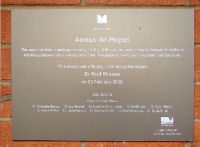
60H2
Larger plaque:
CITY OF
WAVERLEY
THESE EXTENDED FACILITIES FOR
AMAROO NEIGHBOURHOOD CENTRE
WERE OFFICIALLY OPENED BY
HIS WORSHIP THE MAYOR
Cr B F. LYNDON
ON 29 MAY 1993
Smaller plaque:
THE SUPPORT OF
THE
DEPARTMENT OF THE ARTS, SPORT,
THE ENVIRONMENT AND TERRITORIES
IS GRATEFULLY ACKNOWLEDGED
Access to this plaque can only be gained when the centre is open to the public.
Historical Note, 7/1/2009:
Amaroo Neighbourhood House was established on the site of a house, "Wattle Grove" which was, for many years the home of the farming Colwell Family. It was burnt down c.1950. In 1966, the Malvern Corps of the Salvation Army built a hall there. In 1981, Waverley Council purchased the property from the Salvation Army and established a Neighbourhood House, Op Shop and food bank in the building.
Note, 7/1/2009:
Amaroo Neighbourhood Centre provides programs, activities, support groups, child care, health related programs, learning and recreational programs and one-off workshops, and aim to keep all our activities as low cost as possible. We have the services of a large op-shop that provides goods and clothing at very reasonable prices. , We also have an annual art show and host the local Neighbourhood Watch Group. All programs are integrated for persons with a disability where appropriate. We are managed by a committee of management and new members are always welcome.
Waverley Adult Literacy are also housed in Amaroo Neighbourhood House and offer a variety of programs such as ESL classes, computer classes etc

